INVITED REVIEW
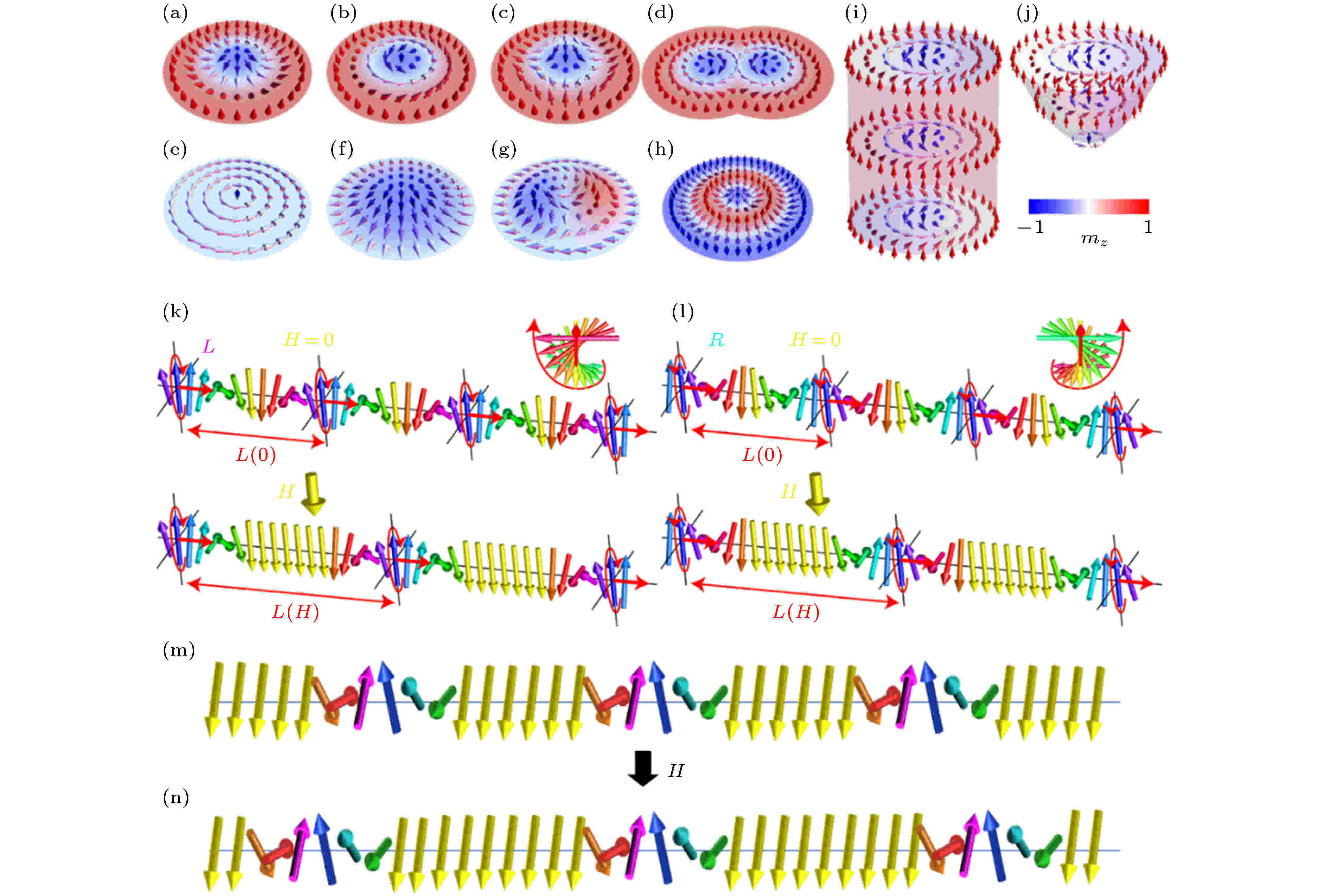
INVITED REVIEW
2020, 69 (11): 117501.
doi:10.7498/aps.69.20200007
Abstract +
With the discovery and development of topological materials, topological physics has attracted enormous research interest in the fields of contemporary condensed matter physics. Topological property, which describes such a property that physical quantity remains invariant under continuous transformation (such as Chern number), has been revealed in a variety of materials, including topological insulators, topological semimetals (such as Weyl or Dirac semimetals), topological magnetic materials, etc. One-dimensional chiral magnetic soliton, similar to magnetic skyrmion, is a type of magnetic configuration with topological origin and quasi-particle property, which has shown tremendous physical properties and device functionalities. In this review, we mainly focus on a chiral helimagnet, called Cr1/3NbS2, which possesses chiral magnetic soliton lattice and other more spin configurations under different conditions. We systematically summarize the work on Cr1/3NbS2, discussing its crystal symmetry, band structure, magnetic interactions, rich magnetic phases, and the physics of associated phase transitions. In particular, the layered crystal structure of Cr1/3NbS2enables us to control the soliton number through tuning the layer number or crystal thickness. Our review provides a comprehensive summary of Cr1/3NbS2in order to draw more attention to this interesting material. Moreover, we envision that our work could offer useful guidance to the researchers working on topological and chiral magnetic materials, and thus introducing topological or chiral magnetism into two-dimensional layered materials and promoting the development of modern magnetism and spintronics. Therefore, this review mainly focuses on a magnet, called Cr1/3NbS2. We systematically summarize the work on Cr1/3NbS2, discussing its crystal symmetry, band structure, magnetic interaction, rich magnetic phases and the interesting physical phenomena occurring at each phase transition. In addition, the layered crystal structure of Cr1/3NbS2also enables us to use the layer number or crystal thickness to modulate and control its rich magnetic phases. We believe that our review provides a comprehensive summary of Cr1/3NbS2, which can make people have a better understanding of a typical topological magnetic material, thereby enriching the material types of magnets and low-dimensional material family and promoting the development of magnetism and spintronics applications, such as in magnetic memory devices, spintronic devices, and quantum information devices.
SPECIAL TOPIC—Majorana in condensed matter
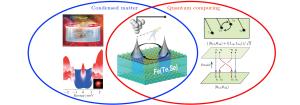
COVER ARTICLE
2020, 69 (11): 110301.
doi:10.7498/aps.69.20200717
Abstract +
During the recent years, the iron-based superconductors with a topological band structure have attracted intensive attention from the science community as a new and promising platform for emerging Majorana zero modes in their vortex core. These topological iron-based superconductors possess all of the desirable properties,i.e.single material, high-Tcsuperconductivity, strong electron-electron correlation and topological band structure, thus successfully avoiding the difficulties suffered by previous Majorana platforms, such as intrinsic topological superconductors and multiple types of proximitized heterostructures. So far, one has observed pristine vortex Majorana zero modes in several different compounds of iron-based superconductors. The systematic studies performed on those systems show that the vortex Majorana zero modes are quite evident experimentally and very clear theoretically, leading to a bright future in applications. The vortex cores of iron-based superconductors can become one of the major candidates for exploring topological quantum computing in the future. In this review article, we will focus on Fe(Te, Se) single crystal, to introduce the original ideas and research progress of the new emerging “iron home” for Majorana zero modes. Having elabrated the basic band structures and the experimental facts of the observed vortex zero modes in Fe(Te, Se), we will systematically summarize the main observations and fundamental physics of vortex Majorana zero modes in Fe(Te, Se). First of all, with the help of the observed behavior of Majorana wavefunction and quasiparticle poisioning, we will analyze the emerging mechanism of vortex Majorana zero modes in Fe(Te, Se). Then we will elaborate the measurements on Majorana symmetry and topological nature of vortex Majorana zero modes, assisted by several existing Majorana theories. After that, we will switch our view angle from quantum physics to quantum engineering, and comprehensively analyze the fate of vortex Majorana zero modes in a real material under a real environment, which may benefit the potential engineering applications in the future. This review article follows the physical properties of vortex Majorana zero modes, and emphasizes the link between theories and experiments. Our goal is to bridge the gap between the classical Majorana theories and the new emerging Majorana platform in iron-based superconductors, and help the readers to understand the experimental observations of the newly discovered “iron home” for Majoranas.
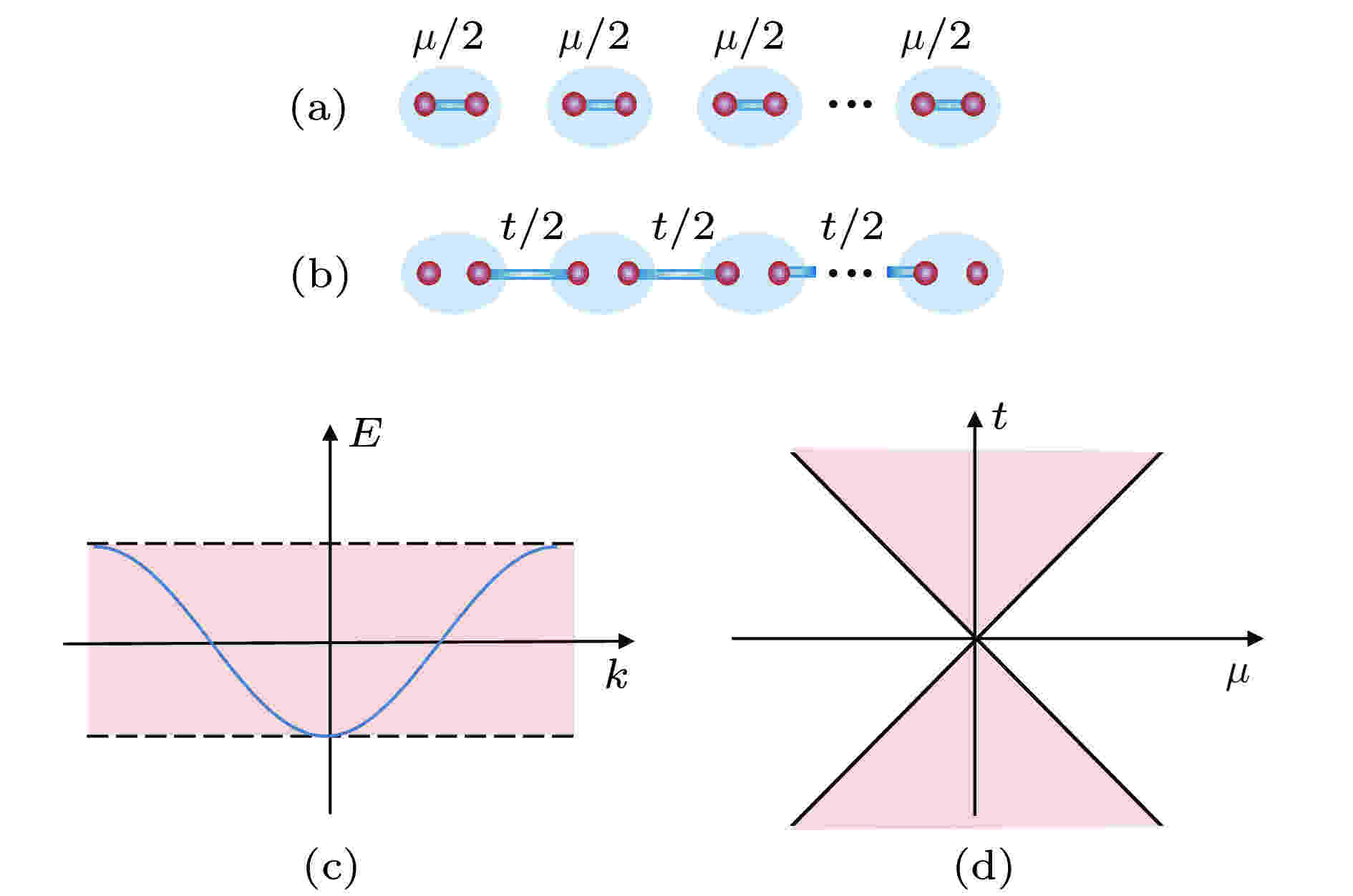
2020, 69 (11): 110302.
doi:10.7498/aps.69.20200812
Abstract +
Since their prediction as fundamental particles in 1937, Majorana fermions have drawn lots of interests in particle physics and dark matter. Their counterparts in condensed matter physics, Majorana zero-Modes (MZMs), have attracted remarkable attention in condensed matter for their potential in building a fault-tolerant quantum computer. Due to the relentless effort, lots of important progress has been made in Majorana physics in the past two decades, as introduced in several excellent review articles. This review focuses on the non-Abelian statistics of MZMs and their application to quantum computation. In the first section of this work, the theoretical progress in searching for MZM is briefly reviewed and the latest experimental progresses are summarized. We next introduce the basic concepts of non-Abelian statistics of MZMs and explain how they can be applied to quantum computation. We then discuss two key experiments to implementing quantum computers in the MZM platform: MZM braiding and MZM qubit readout. In this part, several representative proposals for the Majorana braiding and MZM qubit readout are elaborated. Finally, we introduce a latest concept, the symmetry-protected non-Abelian braiding of Majorana Kramers pairs in time-reversal invariant topological superconductors.
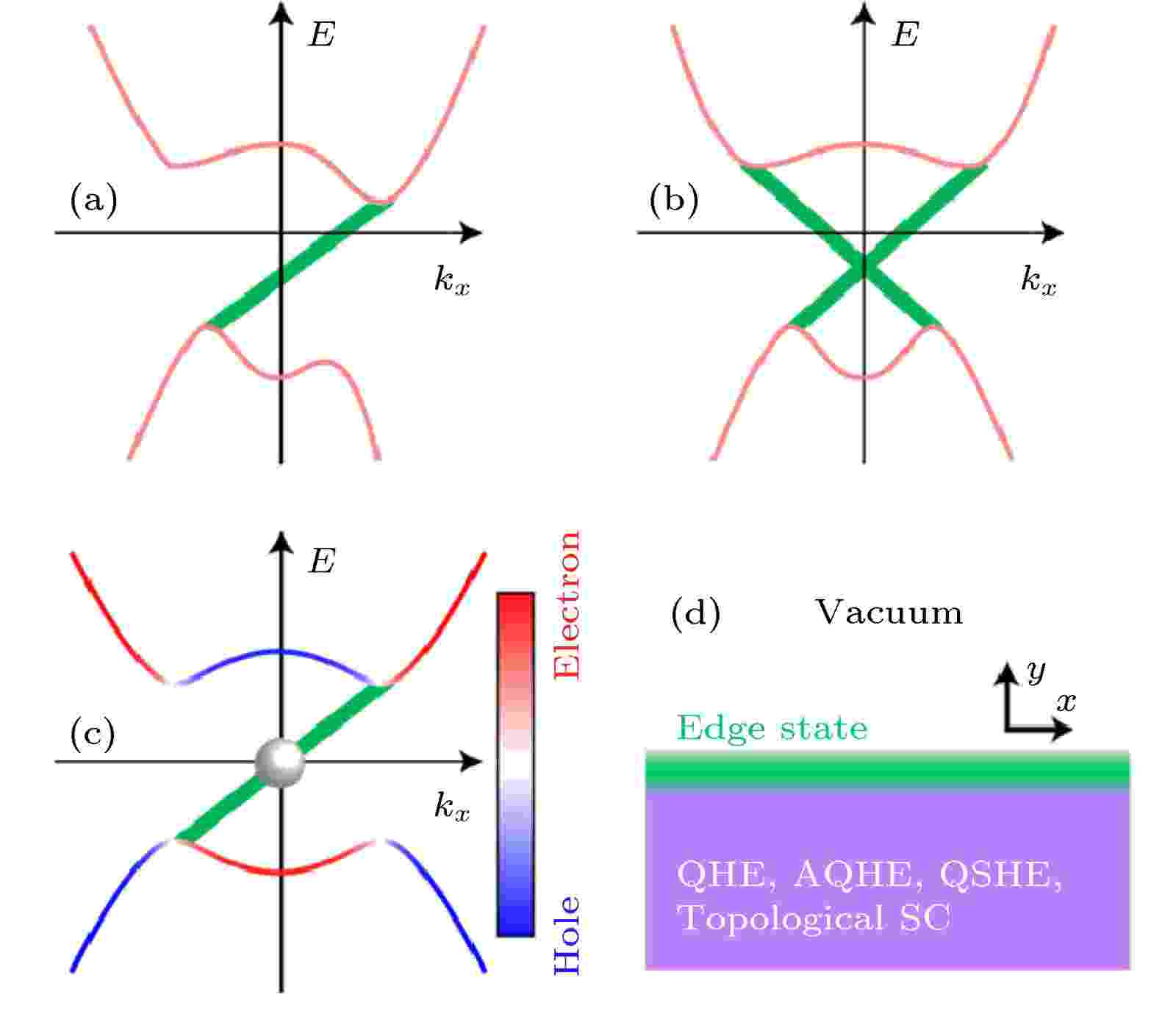
2020, 69 (11): 117102.
doi:10.7498/aps.69.20190959
Abstract +
Majorana bound states are considered useful for realizing topological quantum computation since they obey the non-Abelian quantum statistics. Recent experiments have provided evidences for their existence in some superconducting systems, triggering significant interests from scientists in the field of condensed matter physics and related materials science. In this article, we briefly review the basic concepts and recent developments in the study of Majorana bound states. We first discuss about the origin of the nontrivial topology in superconducting systems within the Bogoliubov-de Gennes mean-field scheme. Then we show the construction of Majorana quasiparticle excitations from an electronic state, and the realization of non-Abelian statistics based on position exchanges of the Majorana bound states hosted in superconductivity vortices. Afterwards we talk about specific one-dimensional and two-dimensional topological superconductors, and propose possible experimental methods for detecting Majorana bound states and operating the Majorana qubits. In particular, a quantum device for Majorana braiding without moving vortices is introduced. Finally, perspectives of the study on Majorana bound states are provided.

2020, 69 (11): 117302.
doi:10.7498/aps.69.20200534
Abstract +
The chiral Majorana fermion, is a massless fermionic particle being its own antiparticle, which was predicted to live in (1+1)D (i.e. one-dimensional space plus one-dimensional time) or (9+1)D. In condensed matter physics, one-dimensional (1D) chiral Majorana fermion can be viewed as the 1/2 of the chiral Dirac fermion, which could arise as the quasiparticle edge state of a two-dimensional (2D) topological state of matter. The appearance of an odd number of 1D chiral Majorana fermions on the edge implies that there exist the non-Abelian defects in the bulk. The chiral Majorana fermion edge state can be used to realize the non-Abelian quantum gate operations on electron states. Starting with the topological states in 2D, we illustrate the general and intimate relation between chiral topological superconductor and quantum anomalous Hall insulator, which leads to the theoretical prediction of the chiral Majorana fermion from the quantum anomalous Hall plateau transition in proximity to a conventional s-wave superconductor. We show that the propagation of chiral Majorana fermions leads to the same unitary transformation as that in the braiding of Majorana zero modes, and may be used for the topological quantum computation.
2020, 69 (11): 117401.
doi:10.7498/aps.69.20200831
Abstract +
Yu-Shiba-Rusinov states are subgap bound states induced by magnetic impurity atoms in a superconductor. These states can be used as building blocks in constructing an effective topological superconductor. Here we formulate a unified theory of topological superconductivity in different dimensions based on Yu-Shiba-Rusinov states, and demonstrate its application with simple but illustrative examples. Such a theory underlies a number of recent experiments on the related platform.
GENERAL

2020, 69 (11): 110201.
doi:10.7498/aps.69.20200116
Abstract +
Since the advent of two-dimensional materials, the micro/nano technology has been greatly developed, and the design of micro/nano fluid devices has become an important research area. As a new two-dimensional material, the black phosphorus (BP) has attracted wide attention because of its excellent properties such as anisotropy, and it has been applied to many areas. In this paper, the axial motion properties of water molecules in the rotating black phosphorus nanotube (BPNT) are studied by the molecular dynamics method. The results show that water molecules in the rotating chiral BPNT can move along the axis, and the moving direction of water molecules is determined by the rotating direction of the nanotube. The velocity of water molecules and the resultant force of water molecules received from the nanotube in the axial direction increase with the angular velocity increasing. The friction coefficient and slip characteristics of the water-BP interface are calculated by using the Couette flow model, and it is clarified that the natural anisotropic microstructure on the surface of BP is the essential reason for the axial motion of water molecules in the rotating BPNT. Besides, we construct a model of filling water molecules between two BPNTs. It is found that the axial movement of water molecules between two nanotubes will be enhanced when the internal and external tube rotate simultaneously. The radius of the nanotubes will also affect the directional motion of the water molecules. Specifically, at the same angular velocity of BPNTs, with the increase of the radius, the axial motion velocity of water molecules in the BPNT will decrease, while the force received from the BPNT will increase. The axial motion of water molecules in the double-walled BPNT is little different from that in the single-walled BPNT, which proves that the number of layers has no significant influence on the driving effect of water molecules. The influence of temperature on the motion properties of water molecules depends on the coupling effect of pressure and temperature in the tube on the convection-solid interface friction coefficient. When the temperature is lower than the normal temperature, the axial velocity of water molecules and the force exerted by the BPNT will increase with the increase of temperature, and when the temperature reaches the normal temperature, it will become stable. The results will provide a theoretical basis for the study of the flow characteristics of the fluid in BPNTs and the application of the fluid drive devices based on BPNTs.
NUCLEAR PHYSICS
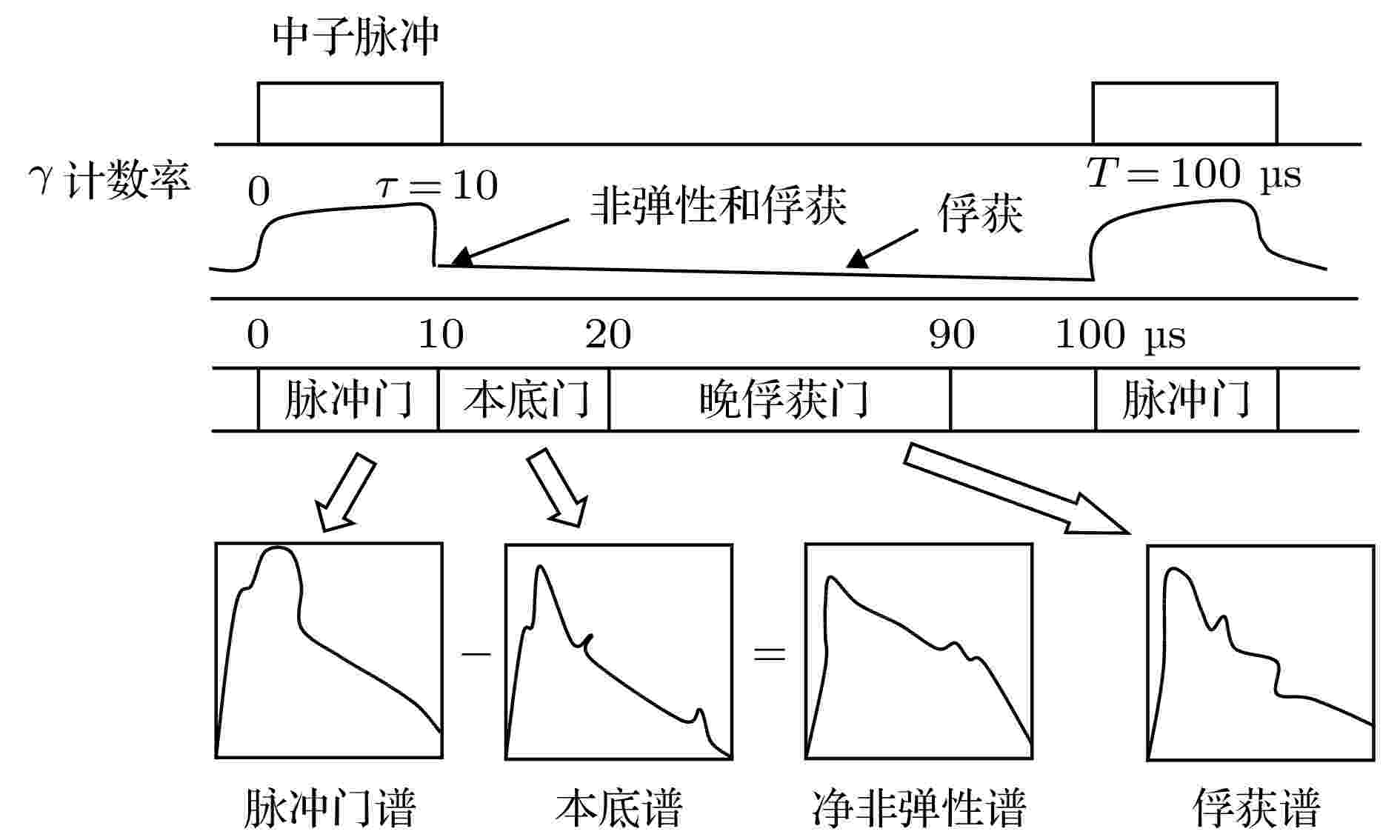
2020, 69 (11): 112801.
doi:10.7498/aps.69.20200279
Abstract +
ATOMIC AND MOLECULAR PHYSICS
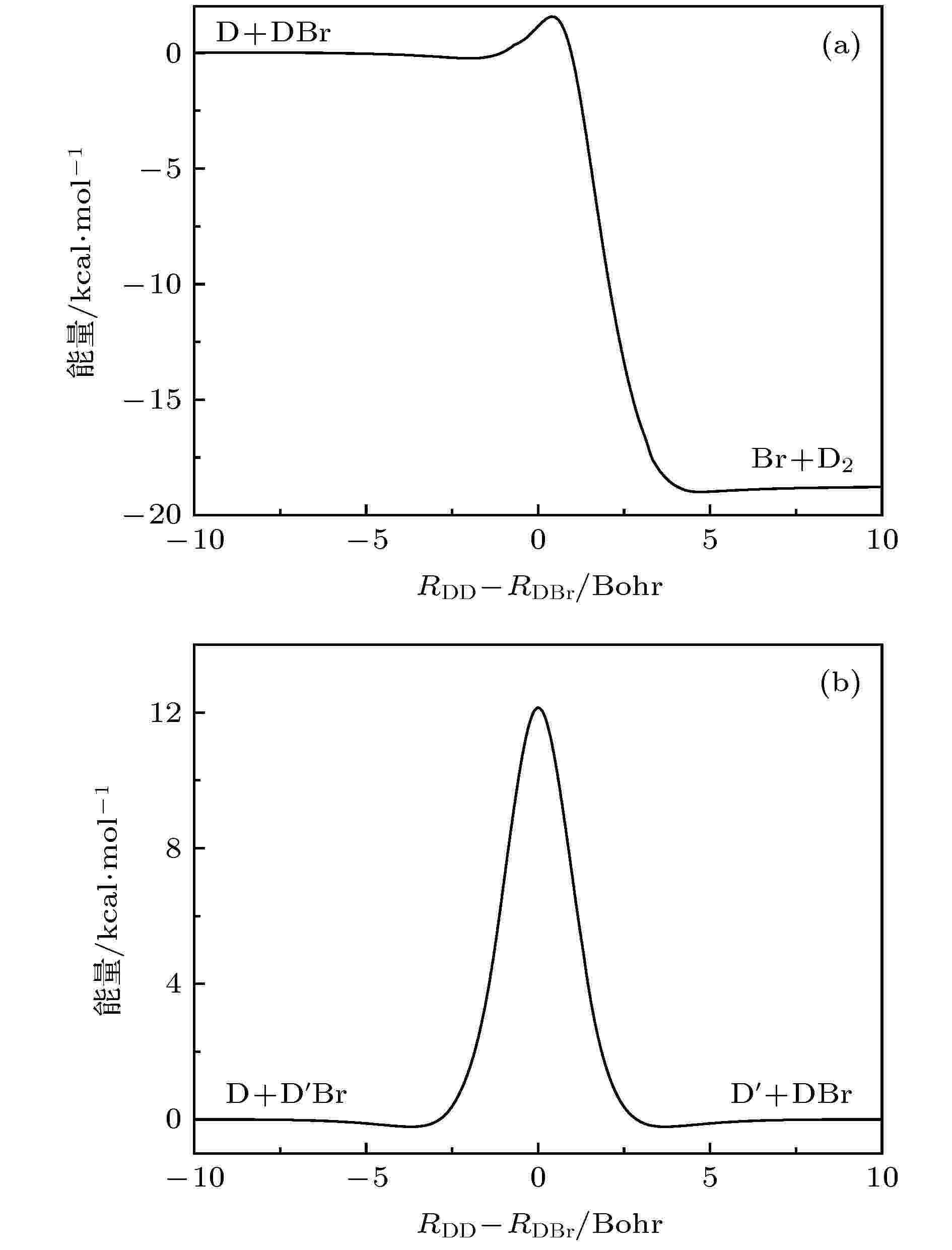
2020, 69 (11): 113401.
doi:10.7498/aps.69.20200321
Abstract +
The state-to-state quantum dynamics studies of the abstraction channel D + DBr → Br + D2and exchange channel
$\rm D' + DBr \to D + D'Br$
of the D +DBr reaction are carried out by using the time-dependent wave packet method with second-order split operator in a collision energy range from 0 to 2.0 eV. The potential energy surface reported by Li et al. (Li W T, He D, Sun Z G 2019J. Chem. Phys.151185102) is adopted in this work. The dynamics properties such as reaction probability, integral cross section (ICS), differential cross section (DCS), the distribution of product ro-vibrational states, specific-state rate constant, etc. are reported and compared with available theoretical and experimental values. The ICSs are compared with the values reported by Zhang et al. and good agreement is achieved between each other, except a little difference at high collision energy. The specific-state rate constants of the title reaction are studied in a temperature range from 200 to 1000 K and present values are in good agreement with experimental data and the Zhang et al.’s results. For abstraction reaction, the backward DCSs reflect the head on “rebound” mechanism dominates in the low collision energy region and abstract mechanism plays a dominant role for the abstraction reaction at high collision energy. In addition, sideward DCSs are observed which stem from the crossing of the two electronic states on the potential energy surface and these values are not reliable. For exchange reaction, the head on “rebound” mechanism dominates the reaction in the collision energy range studied. However, the forward and sideward DCSs are more and more apparent as the collision energy increases.
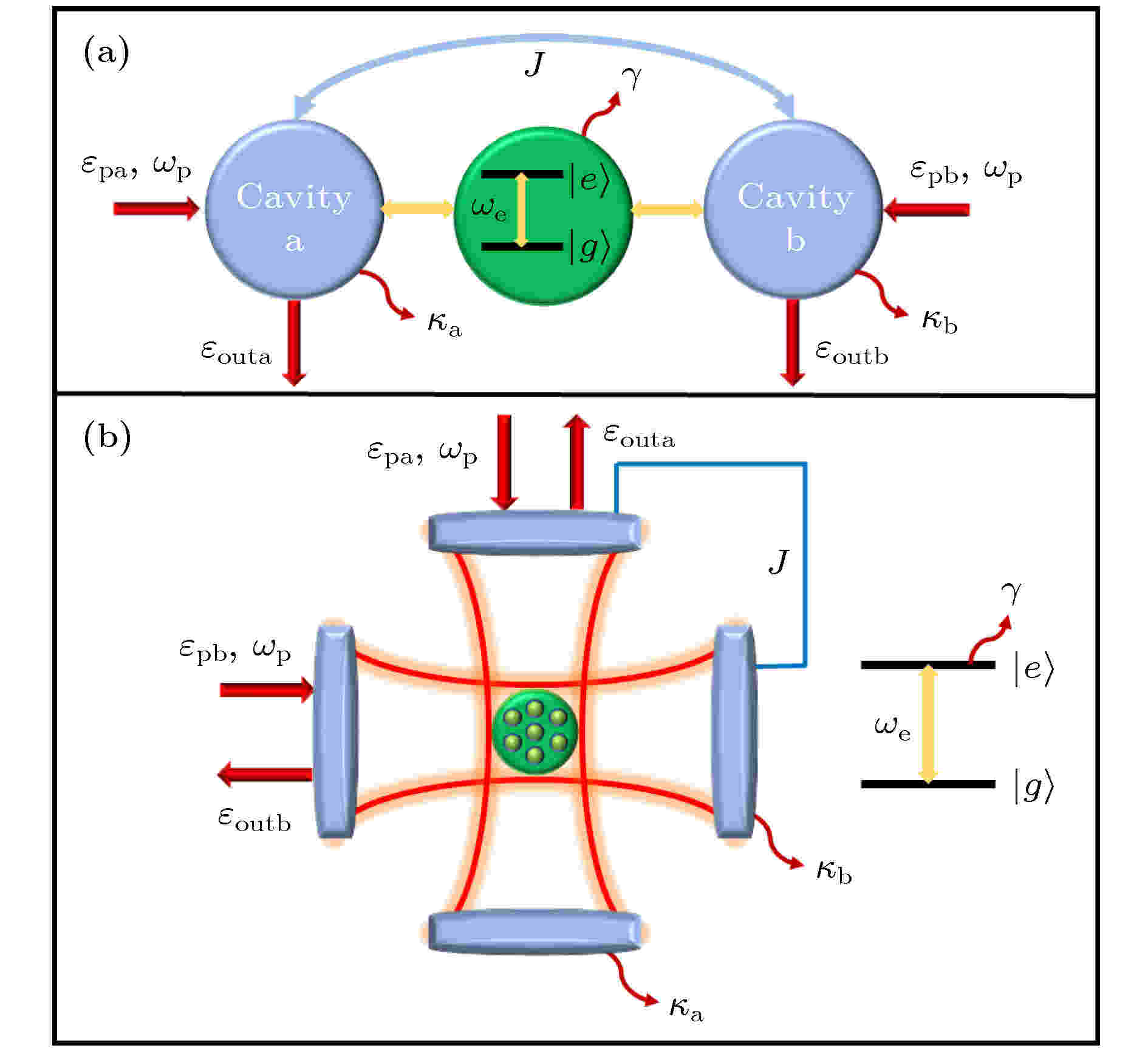
2020, 69 (11): 113701.
doi:10.7498/aps.69.20200184
Abstract +
In recent years, it has been a hot research topic to study the interaction between atomic ensemble and cavities, and many researches have been done in this regard. In such a system, some atoms are trapped in the cavity, which can be used to study their dynamic characteristics, e.g., the evolution of photon numbers and photon transition. The Jaynes-Cummings model is an important model for studying the dynamic characteristics of the cavity-atom system, which is based on the interaction between a single two-level atom and the cavity field. Recently, coherent photon control in cavity under specific conditions has become an important part of quantum computing and communication. It is worth noting that the tunable photon transmission and all-optical switches based on the cavity have already aroused much interest and have been used in many areas. The quantum information and networks are mostly rooted in complex optical devices, which may show nonreciprocal or asymmetric photon transport. In this paper, we demonstrate that by using an optical closed-loop system the unconventional photon transport can be realized with two mutually perpendicular cavities coupled through external fiber and a two-level atom placed on the intersection. This three-mode system supports two orthogonal propagation directions, that is to say, and the interactions among probe fields are mutually perpendicular. Without ignoring the spontaneous decay of the natural atom, the complex and controllable quantum interference induced by the efficient hybrid interaction of the light, cavity modes, and the atom in such a closed-loop structure can result in a few interesting symmetric and asymmetric photon transport behaviors, i.e. coherent perfect synthesis and coherent perfect reflection. Aside from these compelling properties, the group velocity can also be modulated, i.e., fast and slow light effect. All of these processes can be dynamically controlled by using the probe field phase difference, the tunneling coupling between two cavities and the coupling between the cavity and the atom. Importantly, due to so many advantages, such a tunable scheme can be readily extended to some optical devices, e.g., the switch and the router that is challenging to conventional optical devices.
ELECTROMAGNETISM, OPTICS, ACOUSTICS, HEAT TRANSFER, CLASSICAL MECHANICS, AND FLUID DYNAMICS
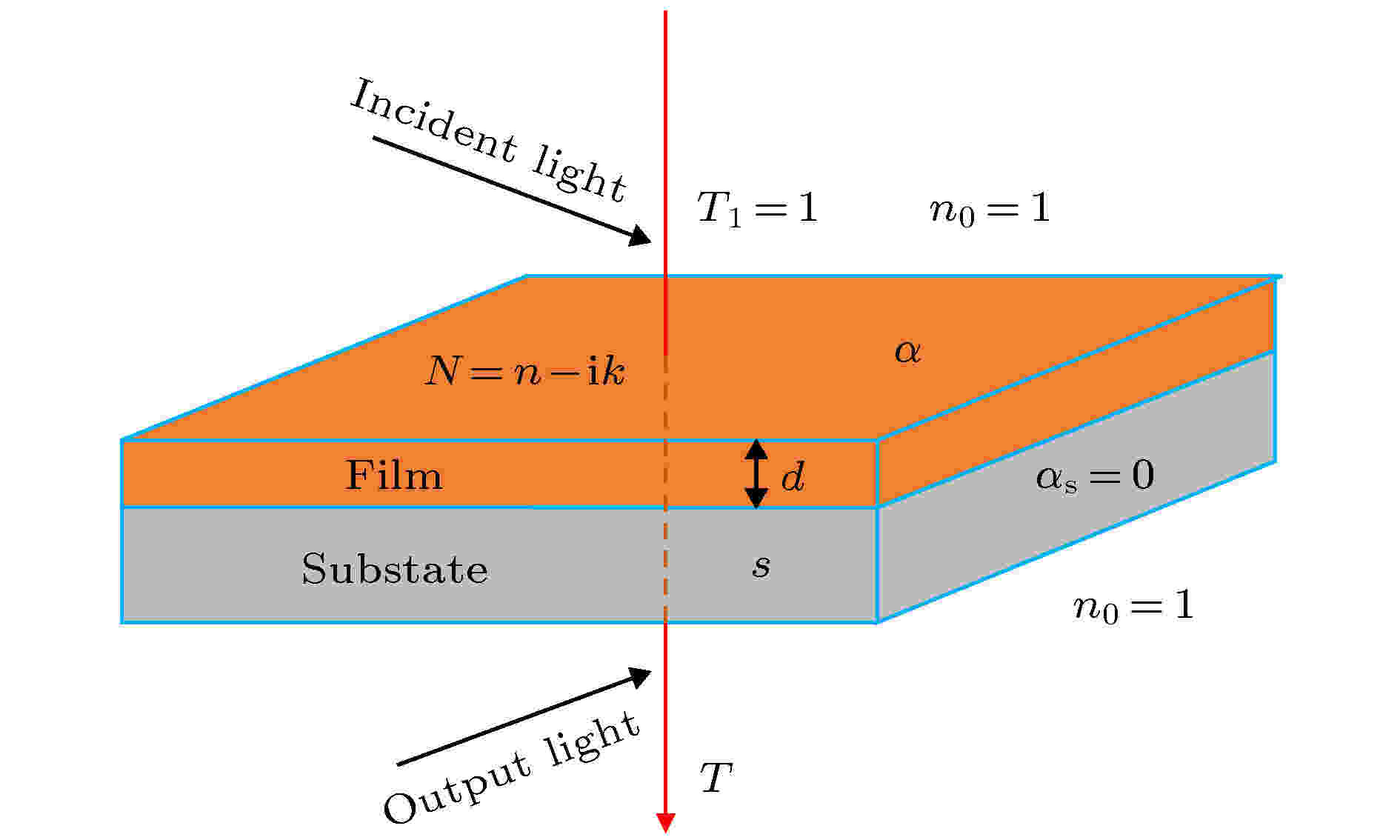
2020, 69 (11): 114201.
doi:10.7498/aps.69.20200145
Abstract +
Multipoint Cauchy method (MCM) is presented to investigate the refractive index and dispersion for each of Ge20Sb15Se65and Ge28Sb12Se60chalcogenide thin films at any wavelength in the transmission spectrum based on the regional approach method and Cauchy fitting. We theoretically calculate and compare the refractive index and dispersion curves obtained by using six different models. The results show that the most accurate results are obtained by the MCM. Two Ge—Sb—Se films are prepared by magnetron sputtering experimentally, and transmission spectrum curves are measured by Fourier infrared spectrometer, the noise is removed by segmental filtering and then the refractive index, dispersion, absorption coefficient, and optical band gap of the two films ina range of 500–2500 nm are obtained by the MCM. The results show that the refractive index of Ge28Sb12Se60film is larger than that of Ge20Sb15Se65film, which is caused by the higher polarizability and density of the former. The refractive indexes of both films decrease with wavelength increasing, so the long waves travel faster than short waves in the two films. The optical band gap of Ge28Sb12Se60film (1.675 eV) is smaller than that of Ge20Sb15Se65film (1.729 eV), and the corresponding wavelengths of the two are 740.3 nm and 717.2 nm. Finally, the microstructures of the two films are characterized by Raman spectra, and the reasons why the two chalcogenide films have different optical properties are explained from the bonding properties between the atoms.
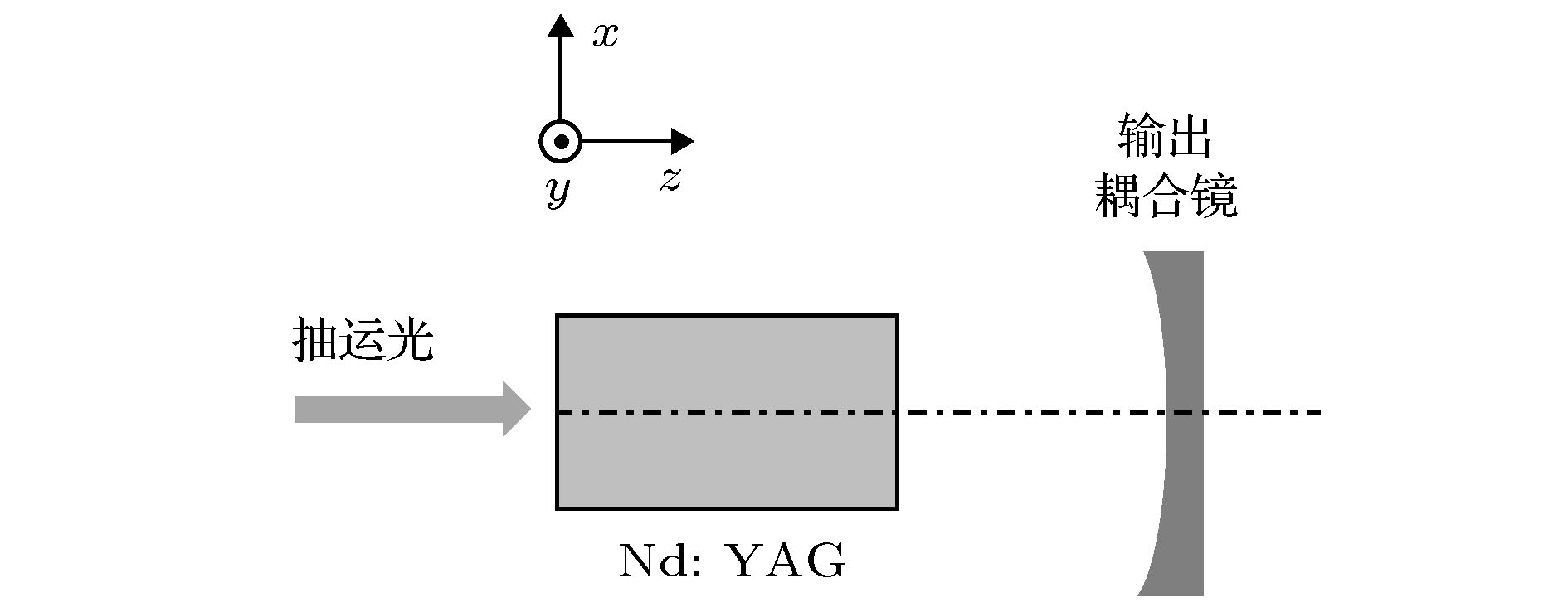
2020, 69 (11): 114202.
doi:10.7498/aps.69.20200086
Abstract +
To study the modes’ pattern and the modes’ competition behavior of an off-axis pumped solid-state laser, a small signal approximation method is derived, which simplifies the multiple-mode differential equations into liner algebraic equations. When the pump beam radius is small, the higher-order Hermite-Gaussian modes emerge successively with the off-axis displacement increasing, while the pattern evolution shows some complexity when the pump radius is larger. The percentage of the modes with a small pump power near the threshold, calculated with the small signal method, is close to that calculated at a higher pump power by directly solving the rate equations numerically. This indicates that we can estimate the modes’ pattern of an actual high power laser by using the small signal method. For a multiple Hermite-Gaussian modes off-axis pumped solid state laser, as the pump power increases, the photon number of the mode increases linearly as its net gain becomes positive, while that of the second mode with a smaller net gain does not increase immediately as it becomes positive successively. Larger pump power is required until the photon number begins to increase. The increasing slope of first mode decreases as the second mode begins to grow. The dynamics of the modes’ competition presents cross spiking and cross relaxation process before they become stable. Moreover, the outputs of the modes HG00-HG50are experimentally demonstrated, and the spot evolution with the off-axis displacement agrees very well with the calculated result.
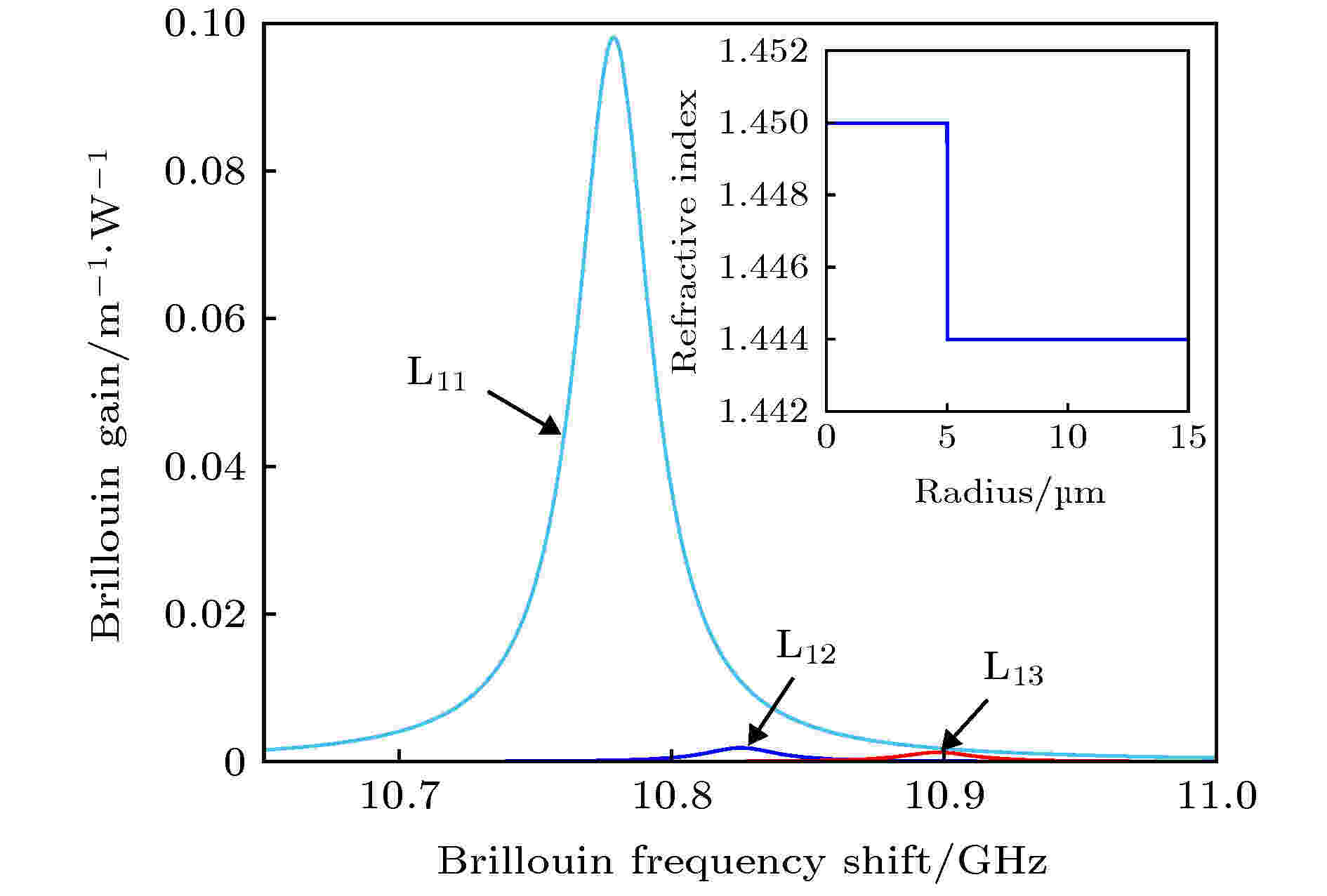
2020, 69 (11): 114203.
doi:10.7498/aps.69.20200103
Abstract +
Stimulated Brillouin scattering (SBS) in a few-mode fiber (FMF) is of significance for the distributed temperature and strain sensing. An FMF with M-shaped refractive index distribution (M-FMF) is proposed in order to improve the performance of simultaneous temperature and strain sensing based on SBS. Propagation of four optical modes is supported by the M-FMF, so that the Brillouin gain spectrum (BGS) can be obtained by both intra-mode and inter-mode SBS. The BGSs produced by the interactions of LP01-LP01mode pair, LP01-LP11mode pair, and LP11-LP11mode pair are analyzed, respectively. Meanwhile, the temperature and strain sensing performance based on the BGS of LP01-LP11mode pair are studied in detail. Considering a common step-index FMF, only one obvious scattering peak is usually present in the BGS obtained from the interaction between different optical mode pairs, therefore, it is inconvenient to achieve multi-parameter sensing measurement. In this paper, the BGS of LP01-LP11mode pair has two scattering peaks, which are contributed by the acousto-optic coupling between the acoustic modes L1n(n= 1, 2) and the optical modes LP01and LP11. The two Brillouin scattering peaks have large gain values of 0.1004 m–1·W–1and 0.0463 m–1·W–1, respectively. More importantly, the gain difference between two Brillouin scattering peaks is small, and the frequency interval is 75 MHz, which can be applied to simultaneous temperature and strain sensing. The influences of the refractive index and the fiber core radius on the BGS of LP01-LP11mode pair are studied. By selecting the optimal structure parameters, we discuss the effect of temperature and strain on the BGS of LP01-LP11mode pair. The errors for simultaneous temperature and strain measurement are reduced to 0.23 ℃ and 5.67 με. Compared with other reported results, our obtained temperature and strain sensitivity are high and sensing errors are low in the considered M-FMF. In other words, based on the BGS of LP01-LP11mode pair, the performance of temperature and strain sensing are improved in the M-FMF. This work is of great significance for studying intra-mode and inter-mode SBS in an FMF. Moreover, the results also provide a guideline for further improving the performance of simultaneous temperature and strain sensing.
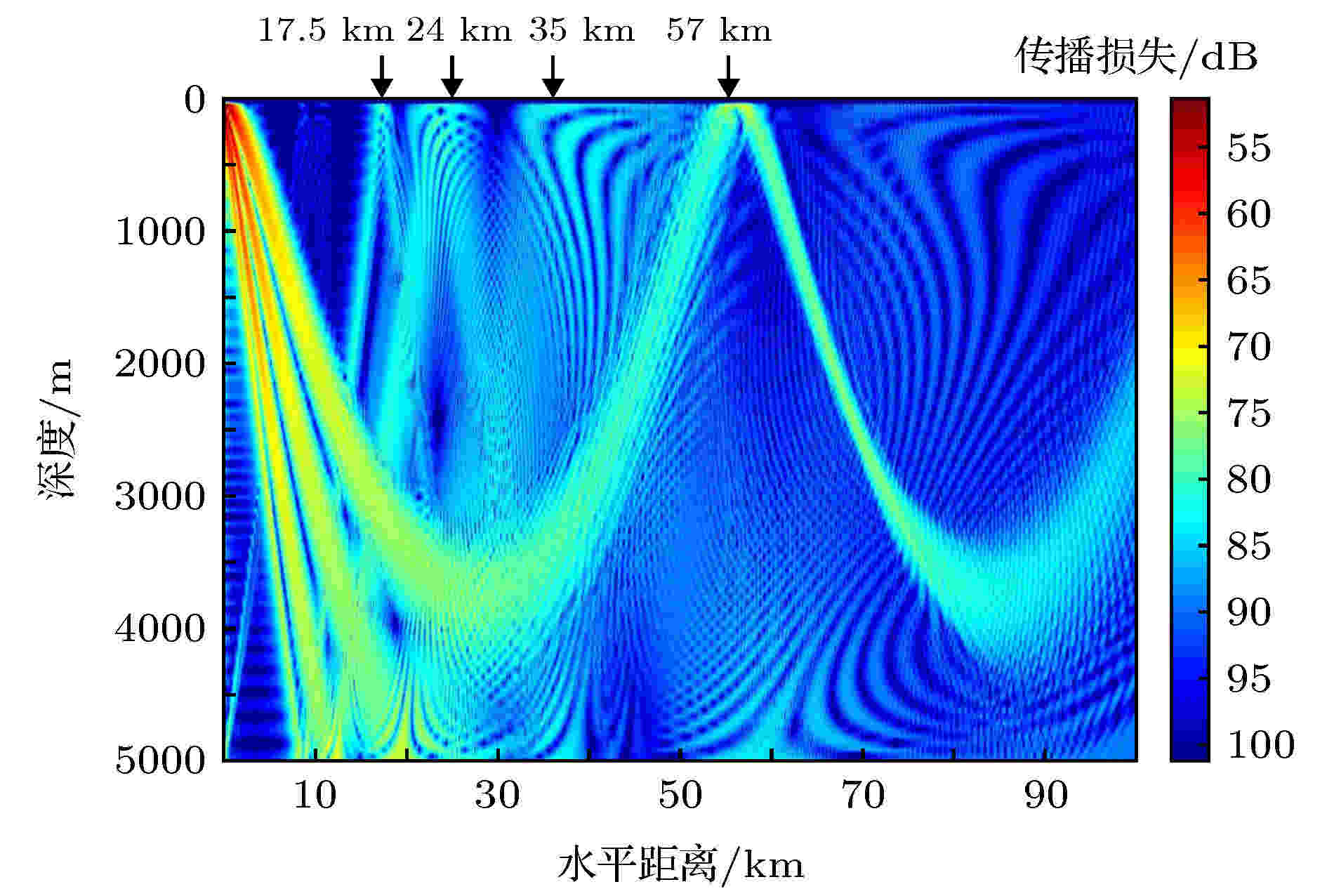
2020, 69 (11): 114301.
doi:10.7498/aps.69.20201652
Abstract +
In the deep ocean environment, the sound energy from the direct path is very hard to illuminate a target located in the shadow zone. To solve the problem, the bottom bouncing technique, in which the vertical transmitting beamforming and the bottom bouncing are used to illuminate the target in the shadow zone, provides a potential way. However, due to the sound field interference in the bottom bouncing area in the deep ocean environment, the sound energy in the bottom bouncing area is fluctuant, which produces several discrete detectable areas. In order to detect underwater targets in these areas when using an active sonar with a transmitting vertical linear array, the selecting of reasonable vertical transmitting beam angles is necessary. Therefore, the relationship between the discrete detectable area and the transmitting vertical angle in deep ocean is very important for the active sonar using a transmitting vertical linear array. In this paper, it is shown that the sound field fluctuation in the bottom bouncing area is due to the energy fluctuation of the rays having different grazing angles. And the active sonar can achieve high noise gain in a detectable area when the vertical transmitting angle is equal to the grazing angle of the sound ray with the peak energy. To obtain a high noise gain of the active sonar using the vertical transmitting array, an efficient method to estimate the grazing angle of sound rays with peak energy according to the sound field distribution of angle dimension is proposed, which is helpful for selecting a group of best vertical transmitting angles. Meanwhile, a transmitting signal which contains a group of subpulses is designed. Furthermore, each subpulse is applied to the whole transmitting array by using the vertical steering to illuminate a certain detectable area in the bottom bouncing area. By doing so, a subpulse steered to the previously selected vertical angle will ensure a high transmitting array gain in a detectable area, and all of pulses will illuminate the whole detectable areas with high array gains almost simultaneously. Numerical simulations show that the proposed method is stable and efficient, and has good noise gain in the shadow zone (where almost no direct path exists) in the deep ocean environment.
PHYSICS OF GASES, PLASMAS, AND ELECTRIC DISCHARGES
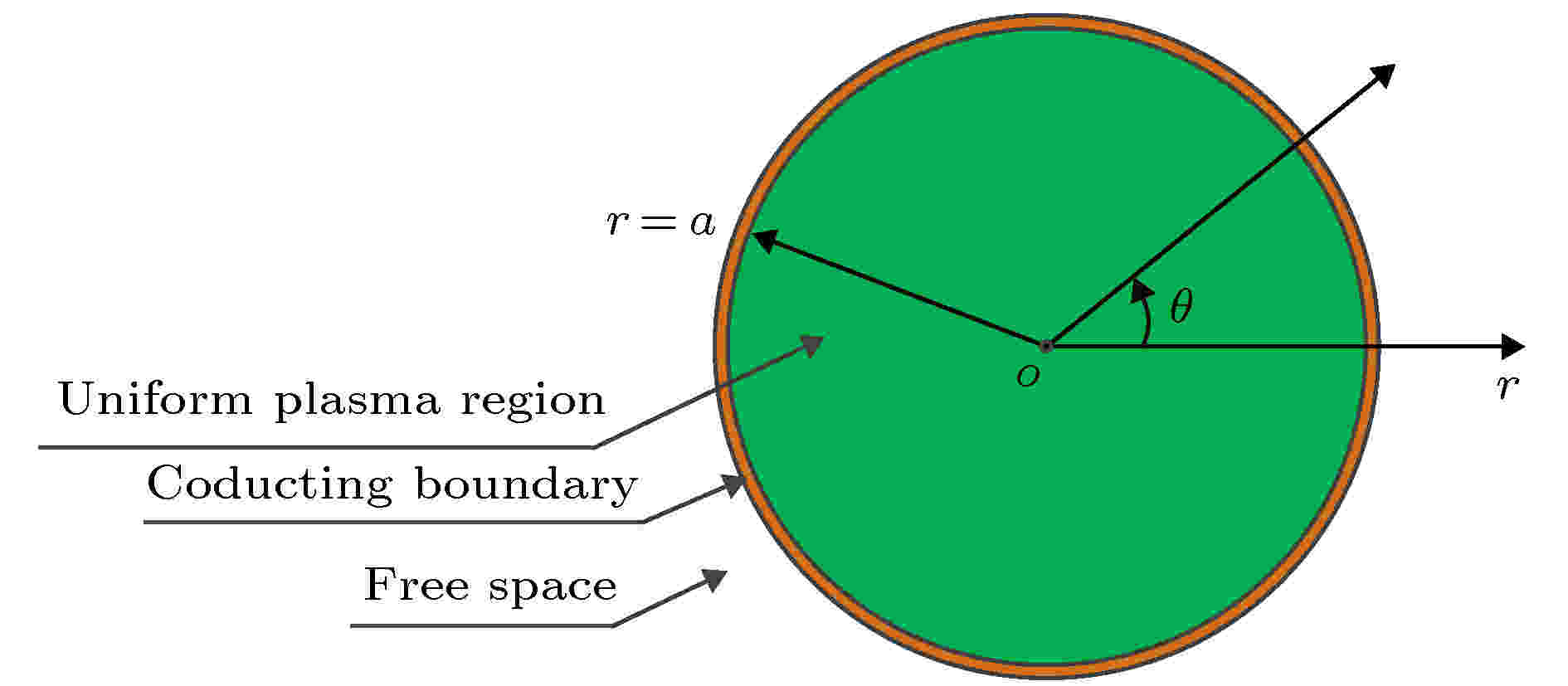
2020, 69 (11): 115201.
doi:10.7498/aps.69.20200062
Abstract +
Based on the finite temperature plasma dielectric tensor model which contains the particle thermal effect, by numerically solving the eigenmode dispersion relation of electromagnetic waves propagating in radially uniform and magnetized warm plasma column which is surrounded by conducting boundary, the mode coupling characteristic and liner damping mechanism induced wave power deposition properties of helicon and Trivelpiece-Gould (TG) waves are parametrically analyzed. The detailed investigations show as follows. Under typical helicon plasma parameter conditions, i.e. wave frequencyω/(2π) = 13.56 MHz, ion temperature is much smaller than electron temperature, for the helicon wave, there exist a cut-off magnetic fieldB0,H,cutoffand a cut-off plasma densityn0,H,cutoff, for which under the conditions ofB0>B0,H,cutofforn0<n0,H,cutoff, the helicon wave becomes an evanescent wave. When the magnetic field intensity changes from 48.4 to 484 G, i.e.,ω/ωceranges from 0.01 to 0.1, for the power deposition intensity, Landau damping of TG wave dominates for them= 0 mode, meanwhile, for them= 1 mode, which wave, i.e. helicon wave or TG wave, plays a major role in power deposition mainly depends on the magnitude of the magnetic field. On the other hand, for a given magnetic fieldB0= 100 G, whenωpe/ωcechanges from 3 to 100, for both them= 0 mode and them= 1 mode, the power deposition induced by Landau damping of TG wave plays a major role, further, one may notice that the power deposition of TG wave decreases while the power deposition of the helicon wave increases as plasma density increases. Finally, for both them= 0 mode and them= 1 mode, the power deposition due to the Landau damping plays a dominant role. All these conclusions provide us with some useful clues to better understanding the high ionization mechanism of helicon wave discharges.

2020, 69 (11): 115202.
doi:10.7498/aps.69.20200212
Abstract +
Short-pulse length and high-power density, intense pulsed ion beam (IPIB) has been widely studied in material processing during past decades. Ablation effect plays a great role in the interaction between IPIB and material and may affect the energy deposition of IPIB, thus further influencing the beam application and diagnostics. Therefore, the investigation of ablation effect on energy deposition of IPIB in the irradiated material is of great significance for its applications and diagnostic techniques. In this work, experiments on the IPIB irradiation are carried out on the BIPPAB-450 accelerator at Beihang University. Its maximum accelerating voltage is 450 kV, peak current density is 150 A/cm2, energy density is 1.5–1.8 J/cm2and pulse duration (FWHM) is 80 ns. Polymer materials which have low thermal conductivity, low decomposition temperature and thus yield to ablation under low beam density, such as polycarbonate (PC), polyvinyl chloride (PVC) and polymethyl methacrylate (PMMA), are chosen in the present research. The 304 stainless steel is used for calorimetric beam diagnostics and comparative analysis. Energy deposition in polymer material and 304 stainless steel are obtained by high infrared imaging diagnostics. It is revealed that the distributions of energy deposition in these two kinds of materials differ from each other obviously. The highest energy density deposited in the 304 stainless steel appears in the center of the irradiated area where focused is the beam with a higher energy density. However, the central energy density in polymer material turns out to be lower than the surrounding area, indicating that a large portion of the ion beam is prevented from reaching the target. Meanwhile, the simulation based on the finite element method is carried out for the thermal filed distribution and evolution under the IPIB irradiation. The simulation result indicates that the strong ablation can be generated on the target surface since the highest temperature caused by IPIB irradiation is much higher than its decomposition temperature. According to the results of experiments and simulation, the polymer material can start to be ablated at the initial stage of IPIB irradiation which will consume partial energy and the products of ablation may act as shielding to block the energy deposition in the same pulse.
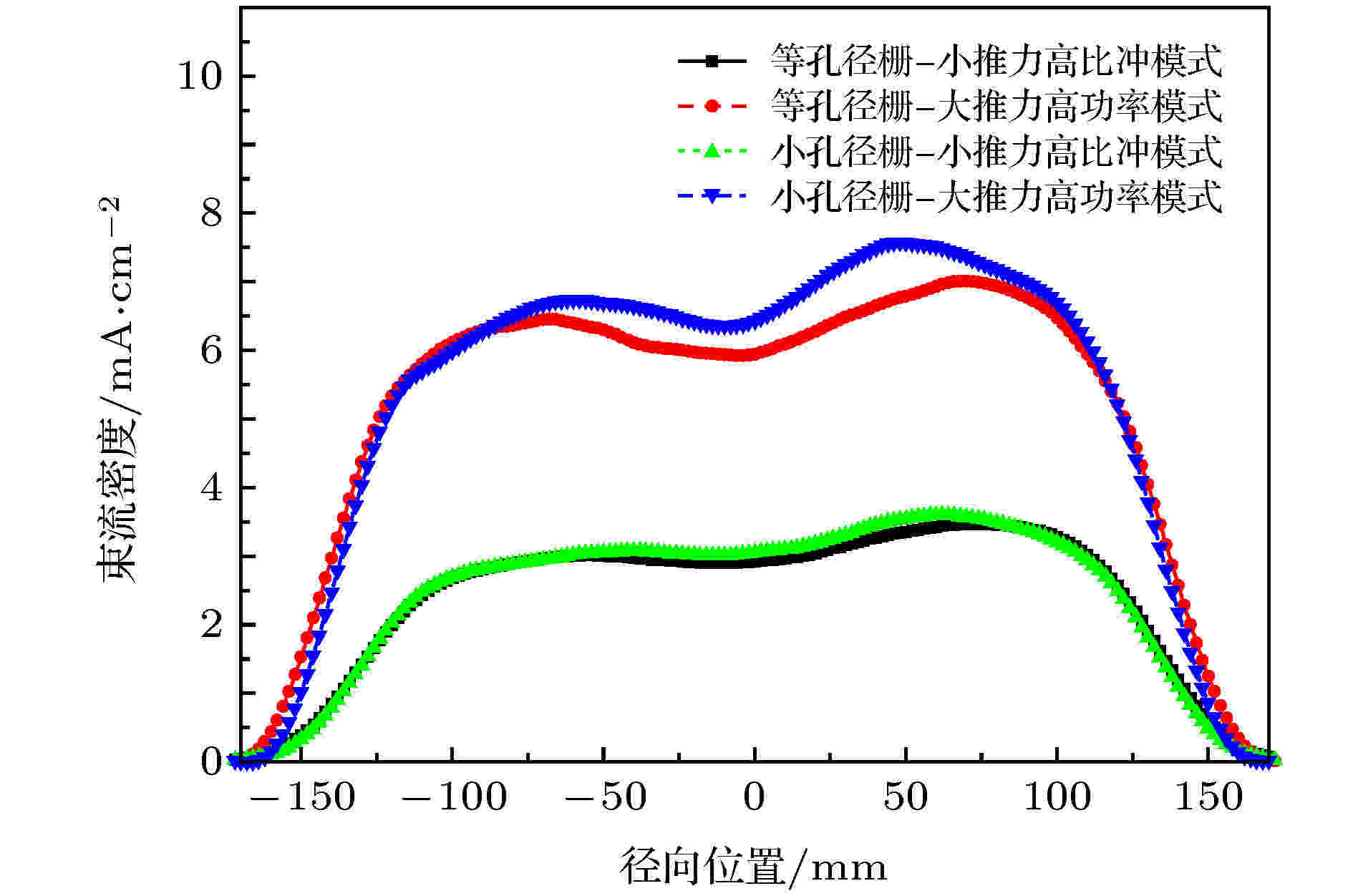
2020, 69 (11): 115203.
doi:10.7498/aps.69.20200358
Abstract +
To eliminate the erosion in the apertures at the edge of the decelerate grid of a dual-mode ion thruster three-grid optical system, a new method of reducing the diameter of the apertures in the outer region of the screen grid is proposed. In order to investigate the method of influencing the discharge loss and the uniformity of the beam current density and also reducing the aperture erosion region and erosion rate of the decelerate grid, two kinds of three-grid optical systems are designed and fabricated with the same material and physical parameters except the diameter of the apertures in the outer region of the screen grid. The first kind is that the diameter of the aperture in the outer region of the screen grid is equal to that in middle region of the screen grid, it is designated as the same aperture diameter grid optical system. The second kind of three-grid optical system is that the diameter of screen apertures whose center distance from the center of grid is larger than 0.95 times the beam radius, is reduced by 26% and therefore the physical transparency of optical system is reduced by 8.8%, it is designated as the small aperture diameter grid optical system. The comparison between the same aperture diameter grid optical system and small aperture diameter grid optical system is performed by assembling them into a 30-cm-diameter dual-mode ion thruster, and the ion thruster performance test, beam flatness test and 600-h-endurance test are conducted in the two typical operation modes, namely the low thrust-high specific impulse mode and large thrust-high power mode. A comparison of small aperture diameter grid optical system with the same aperture diameter grid optical system shows that the discharge loss of the 30-cm dual-mode ion thruster in the low thrust-high specific impulse mode and large thrust-high power mode are reduced by 10% and 21% respectively, the beam flatness is decreased by 3% and 10% respectively, the number of rows of the apertures which are sputtered by beam ions at the edge of the decelerate grid is reduced from 5 to 1. In addition, the erosion rate is significantly reduced and the erosion phenomenon disappears after 900-h-long-duration operation. These results signify that reducing the screen grid aperture diameter in the outer region is an effective method to eliminate aperture erosion at the edge of the decelerate grid of a dual-mode ion thruster three-grid optical system and that this method will not reduce the efficiency of the thruster, but cause the beam current uniformity to worsen.
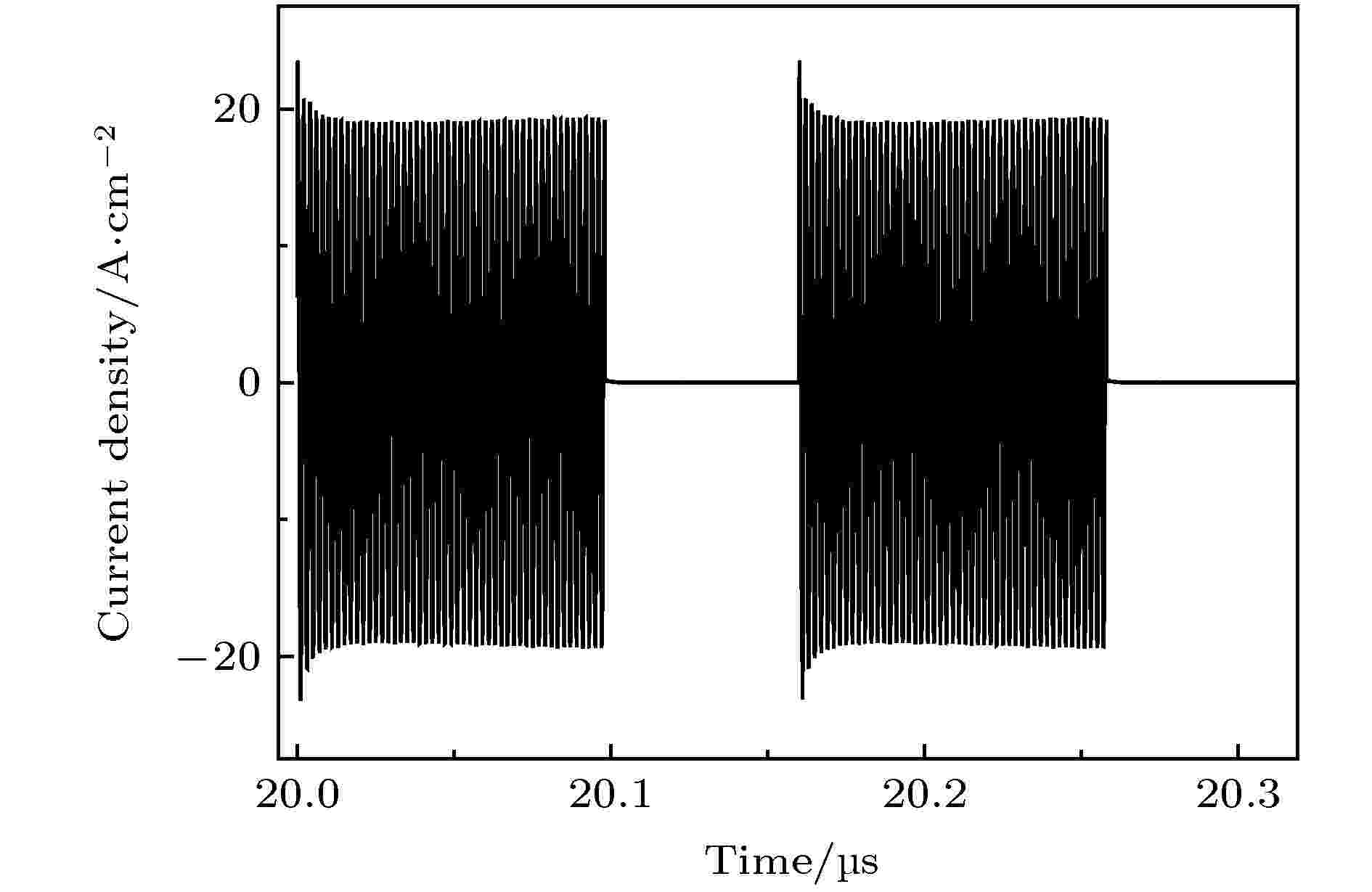
2020, 69 (11): 115204.
doi:10.7498/aps.69.20191853
Abstract +
Pulse-modulated discharge is an effective way to improve the stability of radio-frequency (rf) discharges. Previous studies have shown that with the power frequency increasing to the ultra-high frequency (UHF) band, the introduction of pulse modulation in rf discharges will bring about new discharge behaviors. In this paper, the fluid model is adopted to numerically investigate the new discharge characteristics in dielectric barrier discharges (DBDs) with the rf frequency larger than 500 MHz. A very large current peak occurs in the first positive and negative half cycle during the power-on phase, respectively. The spatial structure of electric field is given to further understand the underpinning physics of the large current peaks. Furthermore, the effects of duty cycle, modulation frequency and voltage modulation rates on the large current peaks are examined based on the computational data. This numerical study will deepen the understanding of DBDs modulated by pulses in the UHF band.
CONDENSED MATTER: STRUCTURAL, MECHANICAL, AND THERMAL PROPERTIES
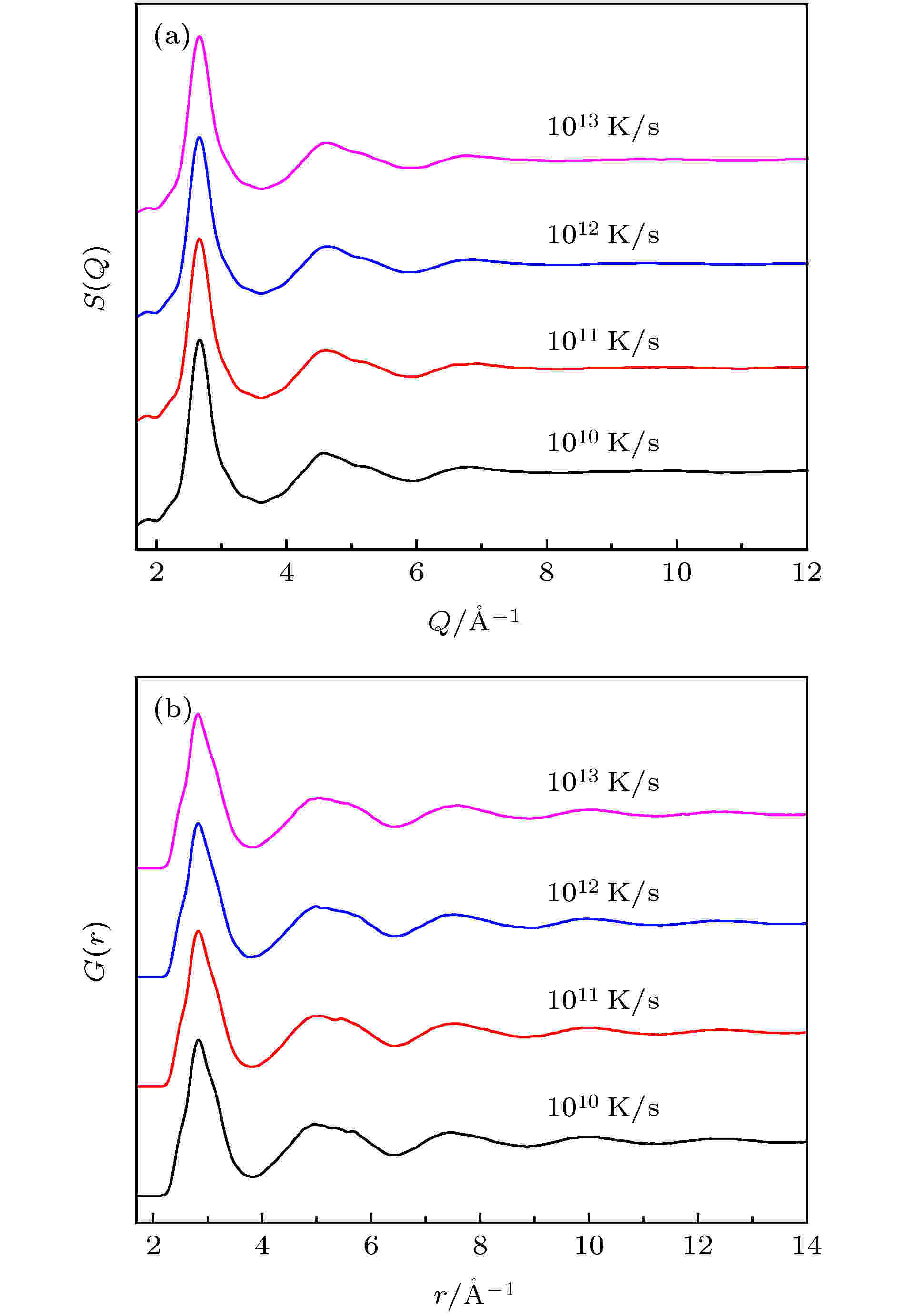
2020, 69 (11): 116101.
doi:10.7498/aps.69.20191781
Abstract +
Since the discovery of the first metallic glass (MG) in 1960, vast efforts have been devoted to the understanding of the structural mechanisms of unique properties, in particular, mechanical properties in MGs, which is helpful for the applications of such novel alloys. As is well known, the cooling rate during the quenching as well as the sample size, significantly affects the mechanical properties in MGs. In order to study the effect of cooling rate on microstructure and deformation behavior in MG by excluding the size effect, Zr48Cu45Al7ternary composition with good glass-forming ability is selected as a research prototype in this work. The classical molecular dynamics simulation is utilized to construct four structural MG models with the same size under different cooling rates, and the uniaxial compressive deformation for each model is also simulated. It is found that an MG model prepared at a lower cooling rate has a higher yield strength and is more likely to form shear bands that lead the strain to be localized, resulting in a lower plasticity. The Voronoi tessellation, together with atomic packing efficiency and free volume algorithms that have been designed by ourselves, is used to analyze the four as-constructed models and high-temperature liquid model. It is found that the as-constructed model, which is prepared by quenching metallic melt at a higher cooling rate, can preserve more structural characteristics of the high-temperature liquid. In other words, the higher cooling rate leads to more clusters with relatively low five-fold symmetry, loose atomic packing and large fraction of free volumes in MG. By calculating the distribution of the free volumes, a new computational approach to detecting liquid-like regions in MG models is adopted. It is found that there are more liquid-like regions in the as-constructed model which is prepared by quenching metallic melt at a relatively high cooling rate. This should be the structural origin of the effect of cooling rate on the deformation behavior, in particular, the yield strength and the plasticity. This work provides an understanding of how the cooling rate during quenching affects the microstructure and deformation behavior, and will shed light on the development of new MGs with relatively large plasticity.
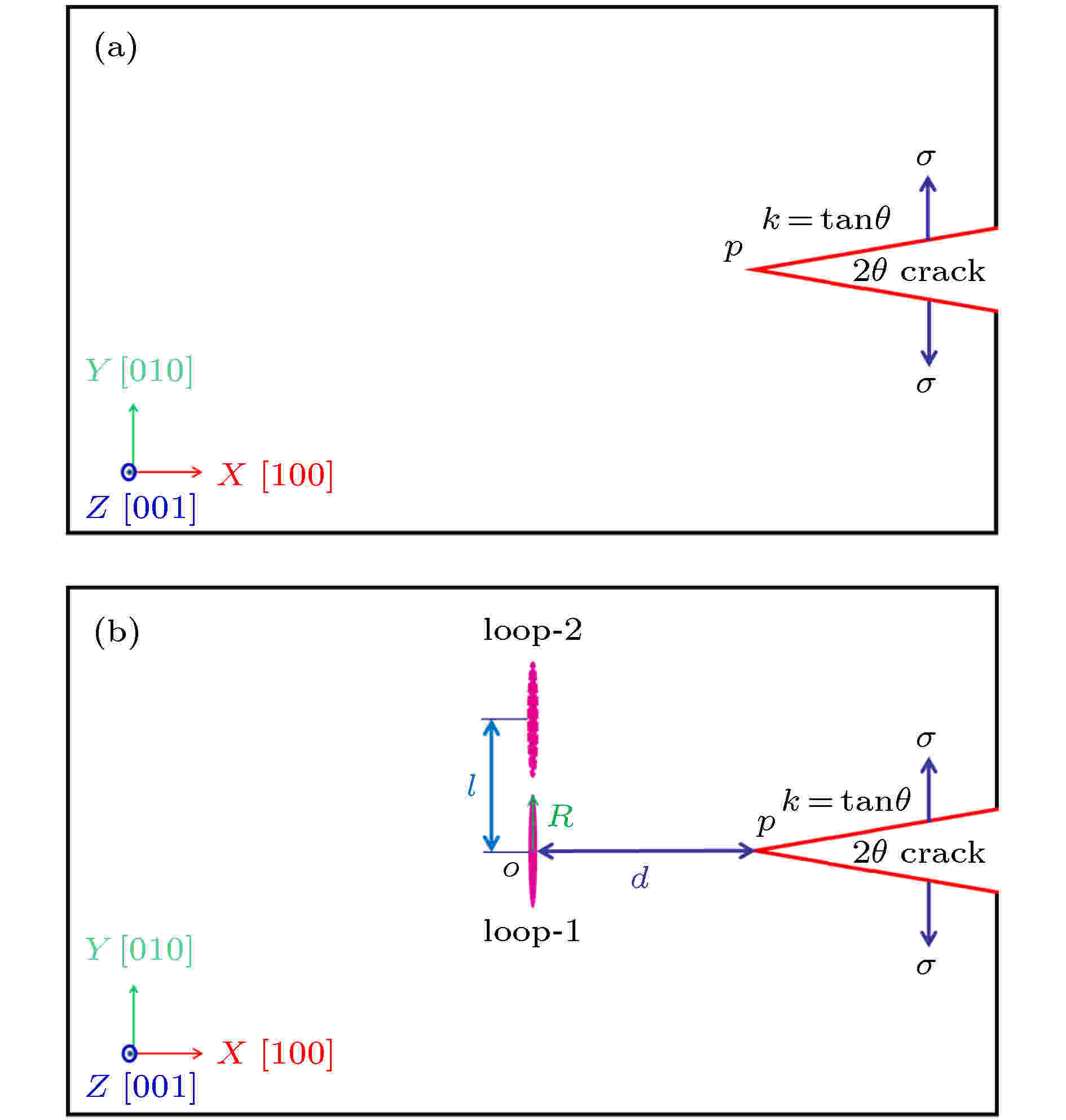
2020, 69 (11): 116102.
doi:10.7498/aps.69.20200317
Abstract +
The interactions between the energetic particles and atoms in materials would result in the atomic displacements and the associated radiation defects. The interstitial dislocation loop, as one of the primary radiation defects, is formed by the clustering of the supersaturated self-interstitial atoms from the displacement damages in body centered cubic (bcc) iron based materials. The radiation hardening, embrittlement, swelling, creep, etc. are generally related to these loops and their interactions with other defects. In addition, the irradiation would also result in the formation of the micro-cracks from the surface of the materials and also from the interface of grains, precipitates, and gas-bubbles inside the materials, which would result in the irradiation assisted stress corrosion crack (IASCC). Therefore, to understand the interaction between interstitial dislocation loop and micro-crack under the irradiation, is one of key steps to understand the underlying mechanism of IASCC. In this work, the interaction between interstitial dislocation loop and micro-crack is simulated by molecular dynamics method on an atomic scale. The distance, relative position between them and radius of dislocation loop, as the main factors affecting their interactions, are studied to explore the underlying reason for inducing the micro-crack to expand on the slip plane. The simulation results indicate that when the interaction between them dominates the whole process with the distance between them within the critical value, the dislocation network containing the
$ \langle 100 \rangle $
and 1/2
$ \langle 111 \rangle $
segments, would interact with the crack tip to inhibit the crack from expanding through the pinning effect. When the size of loop is different, the pining effect would be available only when the interaction between loop core and crack tip dominates with the distance between them within the critical value. All these results provide new understanding for further exploring the IASCC under irradiation.
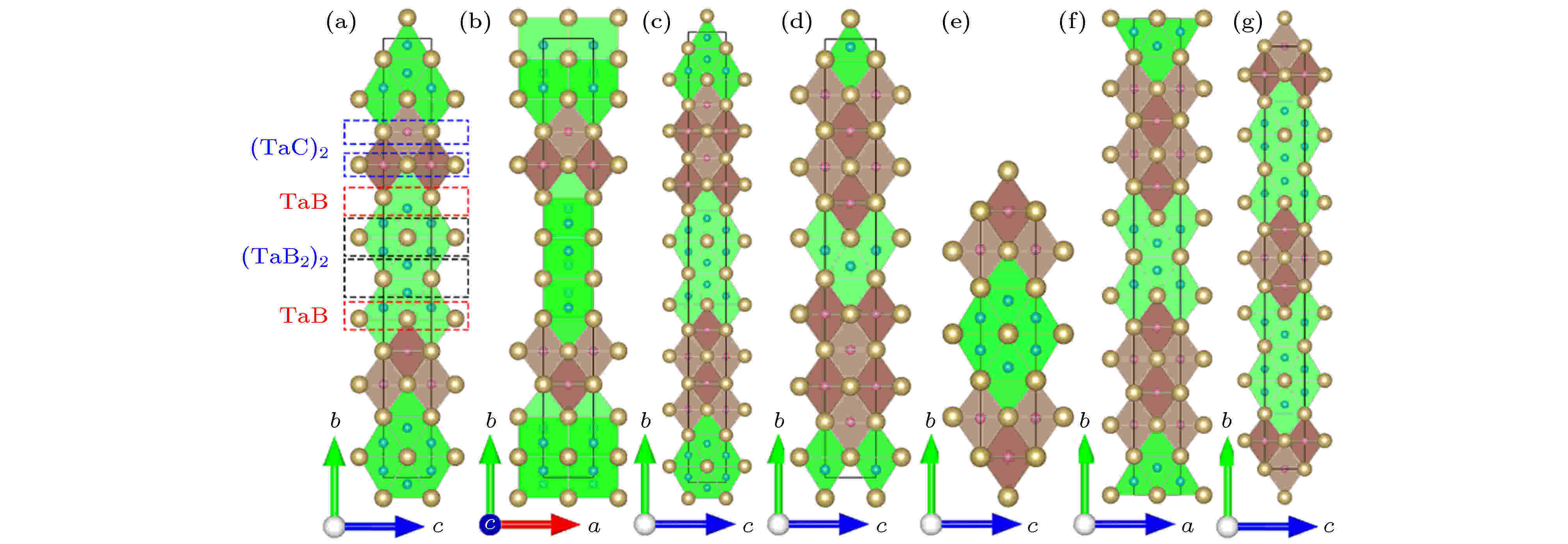
EDITOR'S SUGGESTION
2020, 69 (11): 116201.
doi:10.7498/aps.69.20200234
Abstract +
Transition-metal light-element compounds are potential candidates for hard materials. In the past, most of studies focused on the binary transition metal borides, carbides and nitrides, while the researches of ternary phases are relatively rare. In this paper, the structure units of the known Nb3B3C and Nb4B3C2phases are first analyzed to be Nb6C octahedron and Nb6B triangular prism, respectively. By stacking the Nb6C octahedron and Nb6B triangular prism, twenty ternary Nb-B-C and twenty ternary Ta-B-C configurations with different compositions are constructed. The chemical formula of these Nb-B-C and Ta-B-C configurations can be defined to be Nb(m+n+ 2)B(2m+ 2)Cnand Ta(m+n+ 2)B(2m+ 2)Cn, respectively. Using first-principles density functional calculations, thermodynamical, dynamical and mechanical stabilities of the constructed ternary Nb-B-C and Ta-B-C configurations are investigated through calculating their enthalpies of formation, phonon dispersions and elastic constants. Five Nb-B-C (Nb3B3C, Nb4B3C2, Nb6B4C3, Nb7B4C4and Nb7B6C3) phases and six Ta-B-C (Ta3B3C, Ta4B3C2, Ta6B4C3, Ta7B4C4, Ta7B6C3and Ta3BC2) phases are predicted to be stable by analyzing the constructed ternary Nb-B-C and Ta-B-C phase diagrams, in which the seven phases (Nb6B4C3, Ta3B3C, Ta4B3C2, Ta6B4C3, Ta7B4C4, Ta7B6C3and Ta3BC2) are first predicted to be stable. The Nb6B4C3, Ta6B4C3, Ta4B3C2and Ta3B3C phases are stable when temperature is higher than 1730, 210, 360 and 1100 K, respectively. And the Ta3BC2phase is stable only when temperature is lower than 130 K. The calculated results about mechanical and electric properties show that these Nb-B-C and Ta-B-C phases are conductive materials with a high hardness in a range of 23.8–27.4 GPa.

2020, 69 (11): 116202.
doi:10.7498/aps.69.20200323
Abstract +
Cerium (Ce), a rare earth metal, undergoes a significant (14%−17%) and discontinuous volume shrinkage when subjected to ~0.7 GPa compression at ambient temperature: there happens a first-order isostructural phase transition fromγ-Ce phase toα-Ce phase (these two phases are both face-centered-cubic (fcc) phase). Because of theα→γtransition in Ce under shock compression, the shock front in cerium exhibits a 3-wave configuration: elastic precursor, plastic shock wave inγ-Ce, and phase transition wave corresponding to theγ→αtransition according to the experimental observation. In this paper, a recently developed embedded-atom-method (EAM) potential for fcc Ce is employed in the large-scale molecular dynamics simulations of shock loading onto single crystal Ce to study its dynamic behavior, especially the shock-inducedα→γphase transition, and the orientation dependence with [001], [011] and [111] shock loading. The simulation results show single-wave or multi-wave configuration for shock wave profiles. Under the shock loading along the [001] or [011] crystallographic orientation, the shock wave possesses a 2-wave structure: an elastic precursor and a phase transition wave, while under shock loading along the [111] crystallographic orientation, the obtained shock wave shows a 3-wave profile as observed experimentally. Thus the shock wave structure is obviously dependent on loading orientation. The Hugoniot data obtained in MD simulation show good agreement with the experimental results. The shock loading MD simulation shows lower phase transition pressure than hydrostatic loading, indicating an accelerant role of the deviatoric stress played in the shock inducedγ→αphase transition in Ce. The local lattice structure before and after shocked are recognized with polyhedral template matching and confirmed with radial distribution functions. Under the [011] and [111] loading, the lattice structure maintains the fcc before and after the shocks, and experiences a collapse during the last shock (the second shock for the [011] loading and the third shock for the [111] loading). The lattice structure also maintains fcc before and after the first shock for the [001] loading, while after the second shock the structure type is considered to be body-centered-tetragonal (bct) which is a meta-stable structure resulting from the used EAM potential for Ce. The fcc lattice rotation after shock is observed in the [011] and [111] loading after the phase transition, while no re-orientation occurs in the [001] loading.
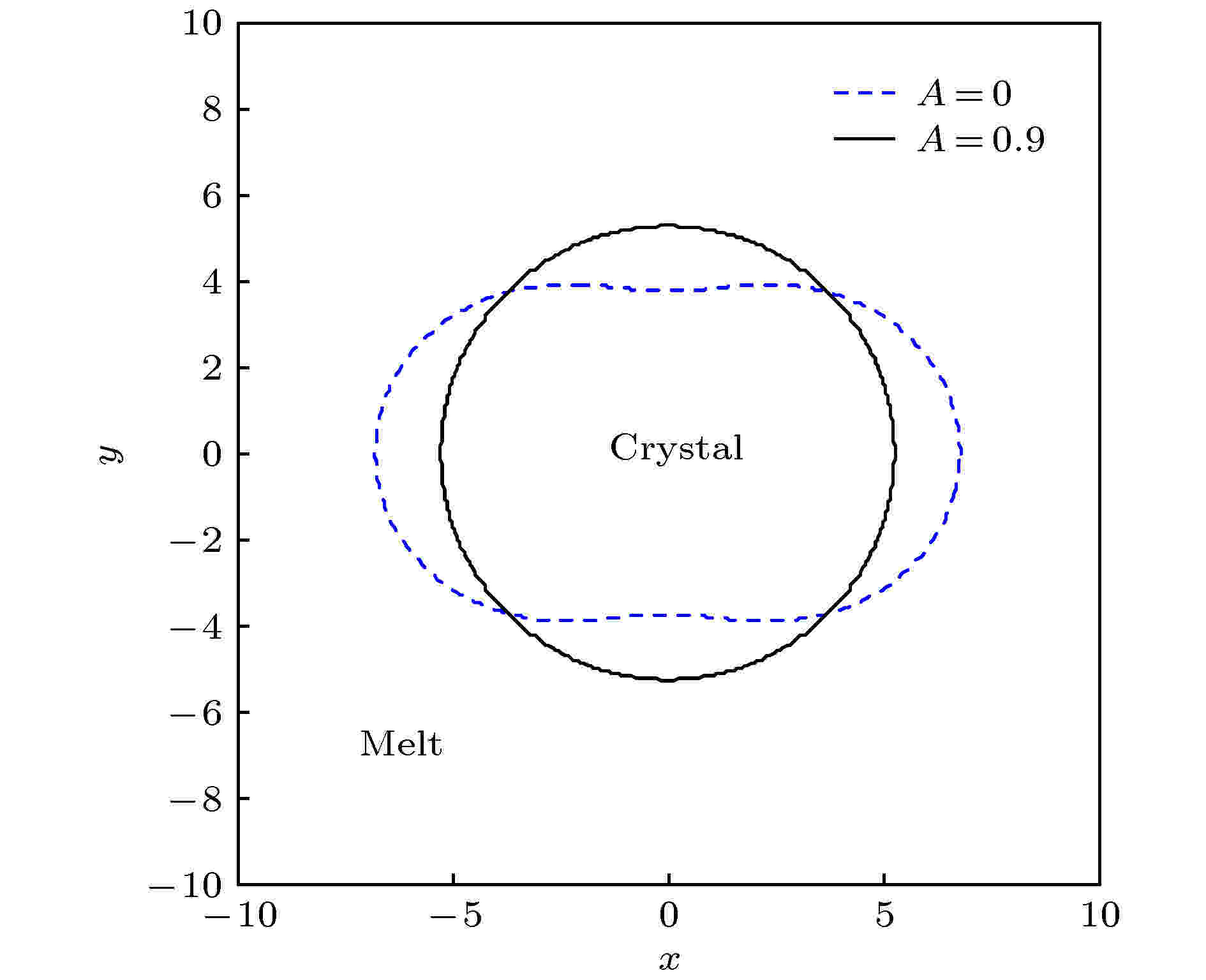
2020, 69 (11): 116401.
doi:10.7498/aps.69.20200233
Abstract +
As an important microstructure, columnar crystal growth technology, especially the growth technology of single columnar crystal plays an important role in improving the performances of semiconductor, optical devices and other related products. In many practical applications, because the alloy is composed of multi-component and there is inevitably flow in the melt, it is necessary to study the growth of columnar crystals in multi-component melt with flow separately. The growth of columnar crystal in a ternary undercooled melt subjected to straining flow under non-isothermal conditions is studied, and the approximate analytical expression for growth morphology of columnar crystal is given by using asymptotic method. It can be seen from the expression that straining flow is an important reason for irregular columnar crystal. When analyzing the effect of straining flow on the growth of columnar crystal in ternary melt, it is found that the incoming flow accelerates the growth velocity of the interface, while the outgoing straining flow reduces the growth velocity of the interface, namely, the straining flow makes the interface of columnar crystal deformed. At the same time, it is found that the interface deformation becomes more intense with the increase of flow velocity. The above conclusion can also be applied to the effect of straining flow on the interface morphology of columnar crystal in pure melt and binary melt. The comparison of the effects of straining flow on the interface of columnar crystal among pure melt, binary melt and ternary melt, shows that the interface morphology of columnar crystal in dilute alloy melt is more affected by straining flow than in the pure melt, but the more components are more easily affected by flow. However, the number of components in melt is not a decisive factor for the change of interface morphology of the columnar crystal, but the constitutional undercooling is an important factor for determining the interface morphology of multicomponent alloy. According to the conclusion of this paper, the influence of straining flow on the interface morphology of columnar crystal growth can be quantitatively predicted, which provides the necessary theoretical guidance in accurately controlling the interface morphology in the future.
CONDENSED MATTER: ELECTRONIC STRUCTURE, ELECTRICAL, MAGNETIC, AND OPTICAL PROPERTIES

2020, 69 (11): 117101.
doi:10.7498/aps.69.20200080
Abstract +
In order to effectively control the type and height of Schottky barrier, it is crucial to appropriately select the material and method of controlling the type and height of the Schottky barrier effectively. Two-dimensional materials exhibit massive potential in research and development due to their unique electrical, optical, thermal and mechanical properties. Graphene is a two-dimensional material found earliest, which has many excellent properties, such as high carrier mobility and large surface area. However, single-layered graphene has a zero band gap, which limits its response in electronic devices. Unlike the graphene, the transition metal sulfides have various band structures and chemical compositions, which greatly compensate for the defect of zero gap in graphene. From among many two-dimensional transition metal sulfides, we choose WSe2. The reason is that the single-layered WSe2possesses the photoelectric excellent performance, band gap that can meet the majority of requirements in electronic and photoelectric devices, and transport properties that can be adjusted to p-type or bipolar which is first found in semiconductor materials. And compared with metal, the graphene at room temperature has superior properties such as high electron mobility, resistivity of 10-6Ω·m lower than copper and silver, coefficient of thermal conductivity 5300 W/(m·K) large than 10 times that of copper, aluminum and other metal, and hardness exceeding the diamond, fracture strength up to 100 times more than that of iron and steel. The Two-dimensional semiconductors along with semimetallic graphene are seen as the basic building blocks for a new generation of nanoelectronic devices, in this sense, the artificially designed transition metal sulfide heterostructure is a promising option for ultrathin photodetectors. At present, most researchers focus on the control of the type and height of Schottky via heterojunction doped metallic element. However, there are few Schottky that are doped by nonmentallic element. Therefore, our work provides the interaction between WSe2and graphene, which are described by the first principles effectively. The results show that there is the van der Waals interaction between the interface of WSe2and that of graphene, and thus forming a stable structure. Through the analysis of energy band, it is found that the semiconductor properties of WSe2are changed by the coupling between WSe2and graphene, making the WSe2transform from direct band gap into indirect band gap semiconductor. Furthermore, the total density of states and corresponding partial density of states of WSe2/graphene heterostructure are investigated, and the results show that the valence band is composed of hybrid orbitals of W 5d and Se 4p, whereas the conduction band is comprised of W 5d and C 2p orbitals, the orbital hybridization between W 5d and Se 4p will cause the photo generated electrons to transfer easily from the internal W atoms to the external Se atoms, thereby forming a build-in internal electric field from graphene to WSe2. Finally, for ascertaining the effect of doping WSe2with nonmetallic elements, the WSe2/graphene Schottky is investigated by using the plane-wave ultrasoft pseudo potentials in detail. Besides, the lattice mismatch rate and lattice mismatch can prove the rationality of doping WSe2by non-metallicelement. The stability of the combination between the doped WSe2and graphene is demonstrated by the interface binding energy. The influence of nonmetallic atoms on WSe2is analyzed before investigating the heterojunction of the doped WSe2and graphene. The results show that the band gap of WSe2doped by O atoms changes from 1.62 to 1.66 eV and the leading band moves upward by 0.04 eV. This indicates that O atom doping has little effect on the band gap of WSe2. When WSe2is doped with N and B atoms, the impurity energy level appears near the Fermi level of WSe2, which results in the band gap being zero, and then it presents severe metallization. This is due to the Fermi level of WSe2shifting. When the C atom is doped, the impurity level appears at the bottom of the guide band of WSe2, and the band gap is 0.78 eV. Furthermore, we analyze the effect of doping on heterojunction. In the W9Se17O1/graphene heterojunction, the Schottky barrier height of n-type and p-type are 0.77 eV and 0.79 eV respectively. It shows that the heterojunction type transforms form p-type into n-type, whose Schottky barrier height is reduced effectively. Due to the W9Se17N1as well as W9Se17B1with metallic properties combining with graphene, the Fermi energy level of graphene is shifted, its Dirac point is located above the Fermi energy level and its conduction band has a filling energy level. When doped with N and B atoms, WSe2/graphene belongs to the type of ohmic contact. When W9Se17C1contacts the graphene, the graphene Dirac point is on the Fermi surface, and the Fermi energy level of W9Se17C1is shifted by 0.59 eV. And then, the height of Schottky barrier of type-n for the heterojunction is 0.14 eV, the height of type-p is 0.59 eV and overall type of heterojunction is type-n. Therefore, by doping WSe2with O, N, C and B, the WSe2/graphene Schottky type and barrier height can be adjusted. These will provide guidance for designing and manufacturing the 2D FET.
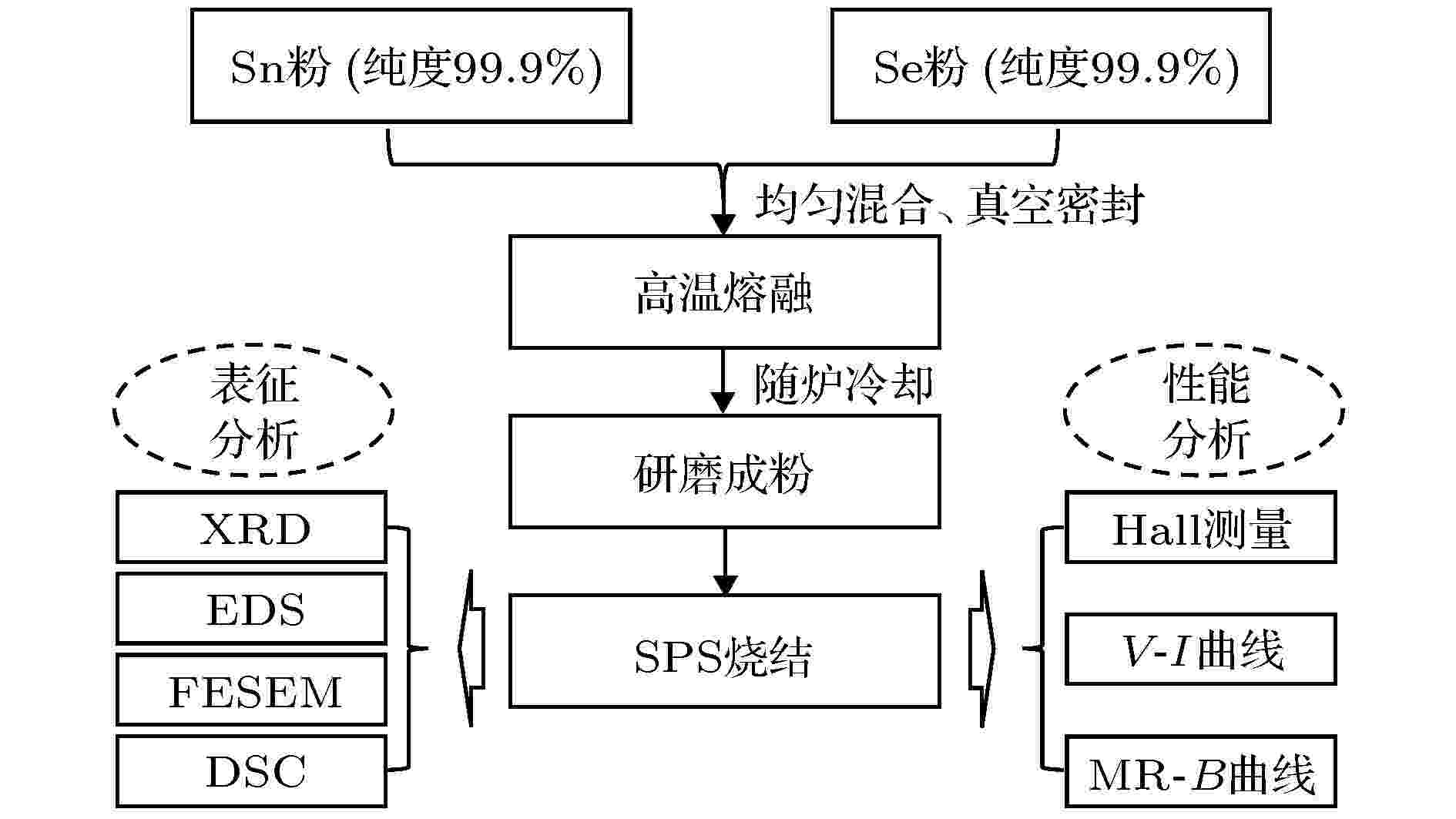
2020, 69 (11): 117301.
doi:10.7498/aps.69.20200160
Abstract +
Memristor and magnetoresistance (MR) are widely used in the field of information storage. In recent years, SnSe2, as an information storage material with both memristor and MR effects, has received a lot of attention of the researchers. It is of great significance to further explore its electrical transport mechanism. In this paper, the high-purity bulk SnSe2samples are prepared by melting method together with spark plasma sintering. TheV-Icurves are measured under different temperatures and magnetic fields. The memristive and MR effect of SnSe2are systematically investigated. After the memristive characteristics are excluded from interfacial junction effect, phase transition and conductive wire channels, the memristive effect at different temperatures is attributed to the space charge limiting current effect under defect control. Under low electric field conditions, the internal carrier concentration of material is much higher than the injected carrier concentration and theV-Icurve obeys ohmic conduction. When the voltage increases to the switching voltageVon, the internal defects of the material are filled with the injected carriers as the transport time of the injected carrier is less than the dielectric relaxation time, and theV-Icurves deviate from ohmic conductivity. When the voltage reaches the transition voltageVTFL, the injected carrier increases exponentially, and theV-Icurve presents negative differential phenomenon. Finally, the space charge inside the material will limit the further injection of external carriers, and theV-Icurve follows the Child law. As the temperature decreases to 10 K, the memristive phenomenon weakens because a large number of defects for accepting the injected carriers are reduced due to the decrease of impurity ionization at low temperatures. At the same time, the sample exhibits a large negative MR at 10 K and 100 K. When impurity scattering predominates, the electrons will be subjected to multiple scattering by the impurities, resulting in localization of carriers. The negative MR effect is related to the inhibition of the carrier localization by the magnetic field. In our work, a large negative MR of about –37% at 0.6 T and 10 K are obtained, which is likely to originate from the disordered distribution of Se vacancy in the material. With the increase of temperature, the scattering mechanism gradually evolves from the impurity scattering into the lattice scattering, and the negative MR effect gradually develops into the positive MR effect.
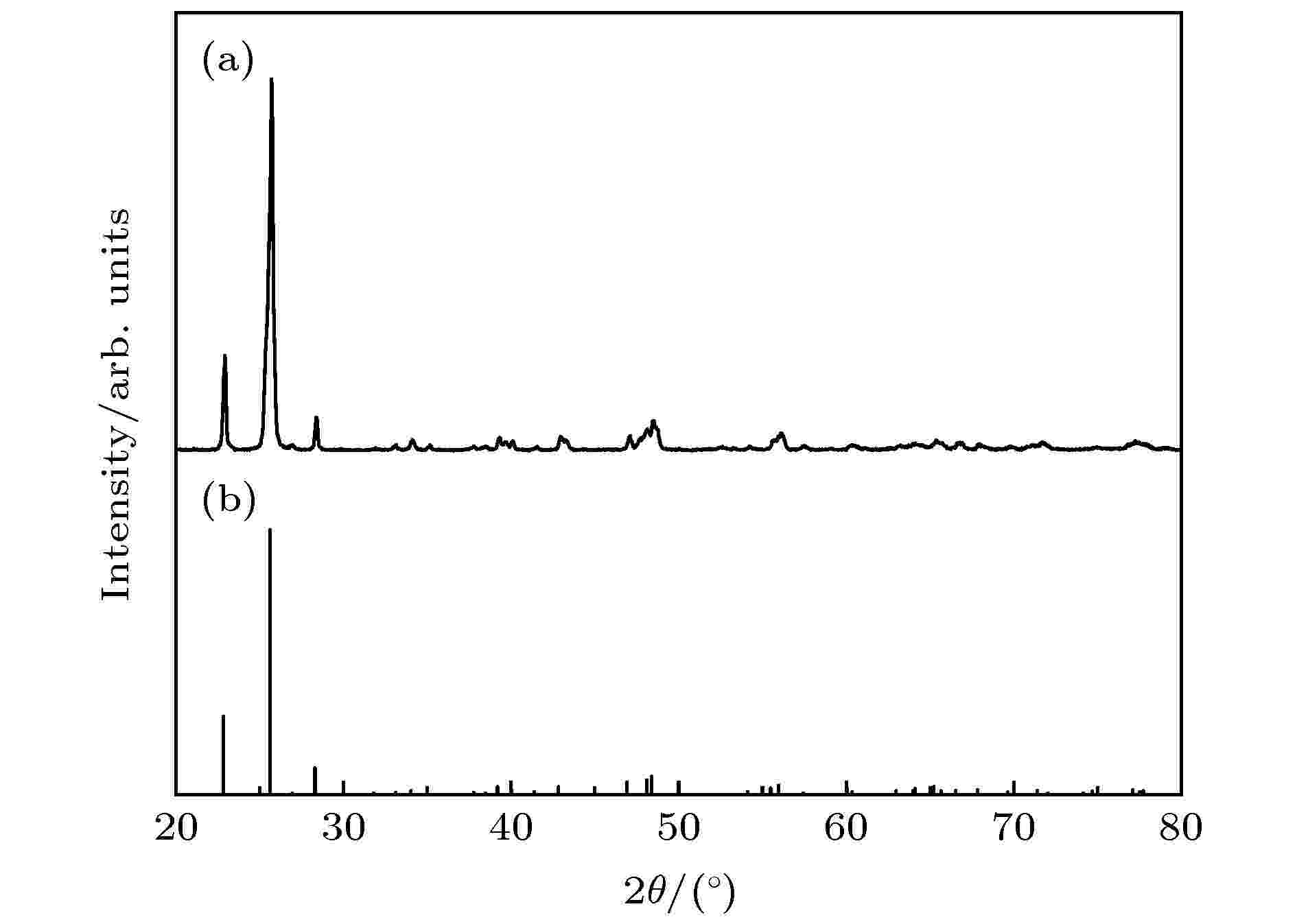
EDITOR'S SUGGESTION
2020, 69 (11): 117701.
doi:10.7498/aps.69.20200232
Abstract +
REVIEW
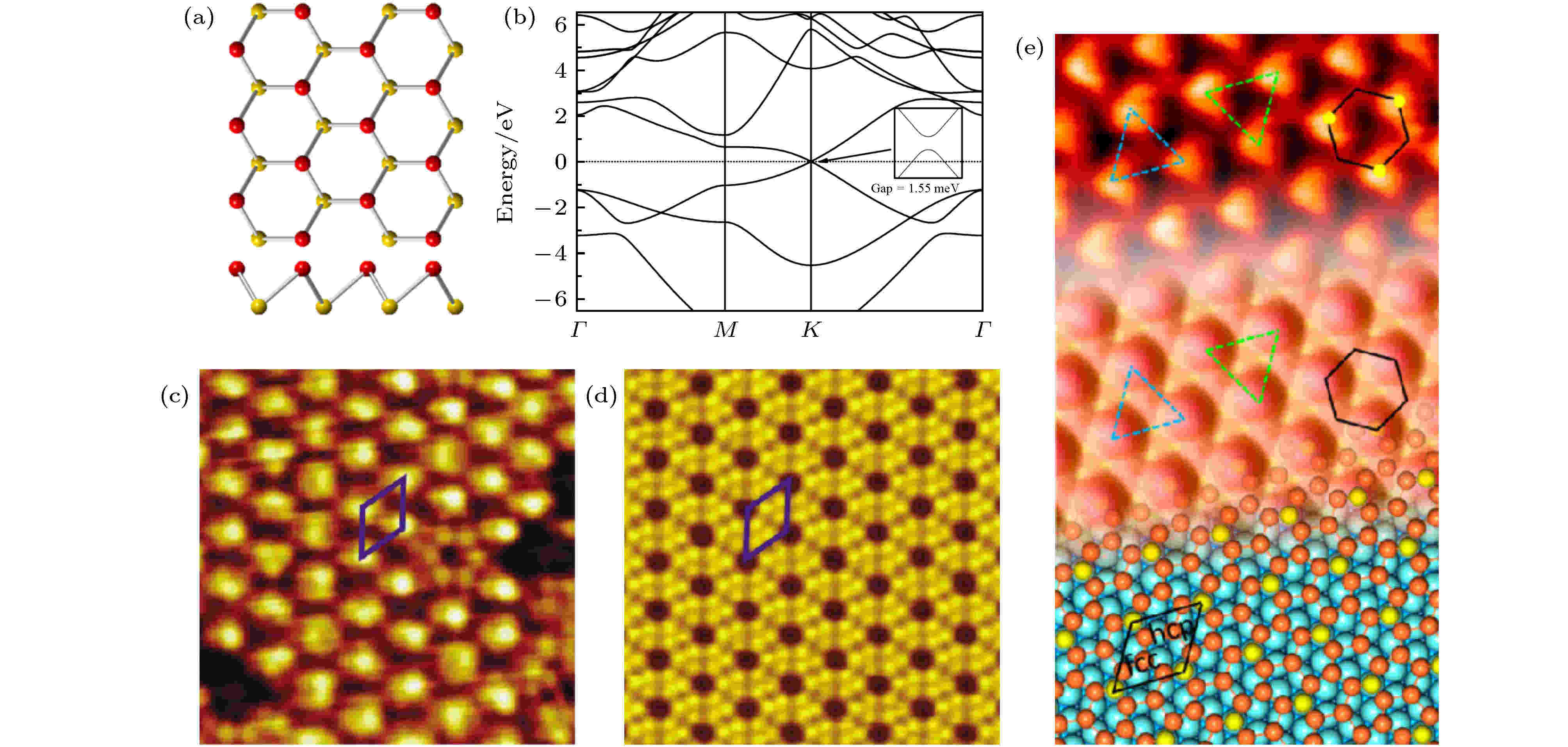
2020, 69 (11): 118101.
doi:10.7498/aps.69.20200174
Abstract +
Two-dimensional atomic crystal materials have similar lattice structures and physical properties to graphene, providing a broad platform for the scientific research of nanoscaled devices. The emergence of two-dimensional materials presents the new hope of science and industry. As is well known, graphene is the most widely studied two-dimensional (2D) material in recent ten years. Its unique atomic structure and electronic band structure make it have novel physical and chemical properties and broad applications in electronic devices, optical devices, biosensors, solar cell, and lithium ion battery. In recent years, graphene-like single-layered 2D materials have attracted much attention. Researches of these 2D atomic crystal materials and their physical properties, on the one hand, are expected to make up for the lack of band gap in graphene, and on the other hand, continue to explore their unique properties, expand the application of 2D atomic crystal materials. Among all the preparation methods of single-layered 2D atomic crystal materials, the molecular beam epitaxy (MBE) is considered to be the most competitive method. The manufacturing process of MBE is usually carried out under ultra-high vacuum condition, which ensures the cleanness of the 2D material surface. At the same time, the solid growth substrate needed for epitaxial growth can be used as a carrier to support and stabilize the growth of 2D materials. In this review, we summarize many single-layered 2D materials prepared by MBE under ultra-high vacuum conditions in recent years, including monatomic 2D atomic crystal materials (silicene, germanene, stanene, hafnene, borophene, phosphorene, bismuthene, antimonene) and binary atomic crystal materials (hexagonal boron nitride, transition metal dichalcogenides, copper selenide, silver telluride). In addition, by scanning tunneling microscopy (STM), low-energy electron diffraction (LEED) and first-principles calculations, we investigate the atomic structures, energy gap modulations, and electrical properties of 2D materials. These 2D atomic crystal materials exhibit the excellent physical properties, which will make them have broad application prospects in future electronic devices. Finally, we summarize the problems faced by the further development of 2D materials and suggest several potential development directions.

EDITOR'S SUGGESTION
2020, 69 (11): 118501.
doi:10.7498/aps.69.20191767
Abstract +
The lead halide perovskite nanocrystals (NCs) have become more ideal luminescent materials due to the excellent properties such as narrow emission linewidth, photoluminescence quantum yield (PLQY), adjustable spectrum and facile preparation in comparison with traditional II-VI or III-V group semiconductor NCs. Until now, the external quantum efficiency (EQE) of light-emitting diode (LED) devices using perovskite NCs as emitting layers, has reached > 20%. This optical performance is close to that of the commercially available organic LED, which shows their great potential applications in solid state lighting and panel displaying. However, when perovskite NCs suffer light, heat and polar solvent, they exhibit the poor stability owing to the intrinsic ion properties of perovskite, and highly dynamic interface between NCs and ligands as well as the abundant defects on the surface of NCs. Therefore, how to elevate their stability is a key and urgent problem. In this review, three methods to improve the stability of NCs are summarized: 1)In situsurface passivation with tight-binding or protonation-free sole ligands such as oleic acid (OA), oleamine (OAM), dodecyl benzene sulfonic acid, octylphosphonic acid, sulfobetaines, lecithin and two ligands such as 2-hexyldecanoic acid/OAM, bis-(2,2,4-trimethylpentyl)phosphinic acid/OAM as well as three ligands such as OA/OAM/Al(NO3)3·9H2O, OA/OAM/tris(diethylamino)phosphine); the postsynthetic ligand exchange or passivation with 1-tetradecyl-3-methylimidazolium bromide, 2-aminoethanethiol, silver-trioctylphosphine complex and n-dodecylammonium thiocyanate; 2) the doping of Cs+by FA+, Na+and the doping of Pb2+by Zn2+, Mn2+, Cd2+, Sr2+, Sb3+in perovskite NCs; 3) the surface coating with inorganic oxides (SiO2, ZrO2, Al2O3, NiOx), inorganic salts (NaNO3, NH4Br, PbSO4, NaBr, RbBr, PbBr(OH)), porous materials (mesoporous silica, zeolite-Y, lead-based metal-organic frameworks), polymer materials (polystyrene, poly(styrene-ethylene-butylene-styrene, poly(laurylmethacrylate), poly(maleic anhydride-alt-1-octadecene), polyimide, poly(n-butyl methacrylate-co-2-(methacryloyloxy)ethyl-sulfobetaine)). Besides, we make some suggestions to further improve the stability of NCs as follows: 1) Developing the surface ligands with good dispersity and multi-coordination groups; 2) theoretically studying the influence of ion doping on the structure and stability; 3) realizing the stable and conductive metal oxides shell for uniform and compact encapsulation of NCs core. In a word, these conventional methods can enhance the stability of NCs to a certain extent, which fail to meet the requirements for practical application, so more efforts will be needed in the future.
INTERDISCIPLINARY PHYSICS AND RELATED AREAS OF SCIENCE AND TECHNOLOGY
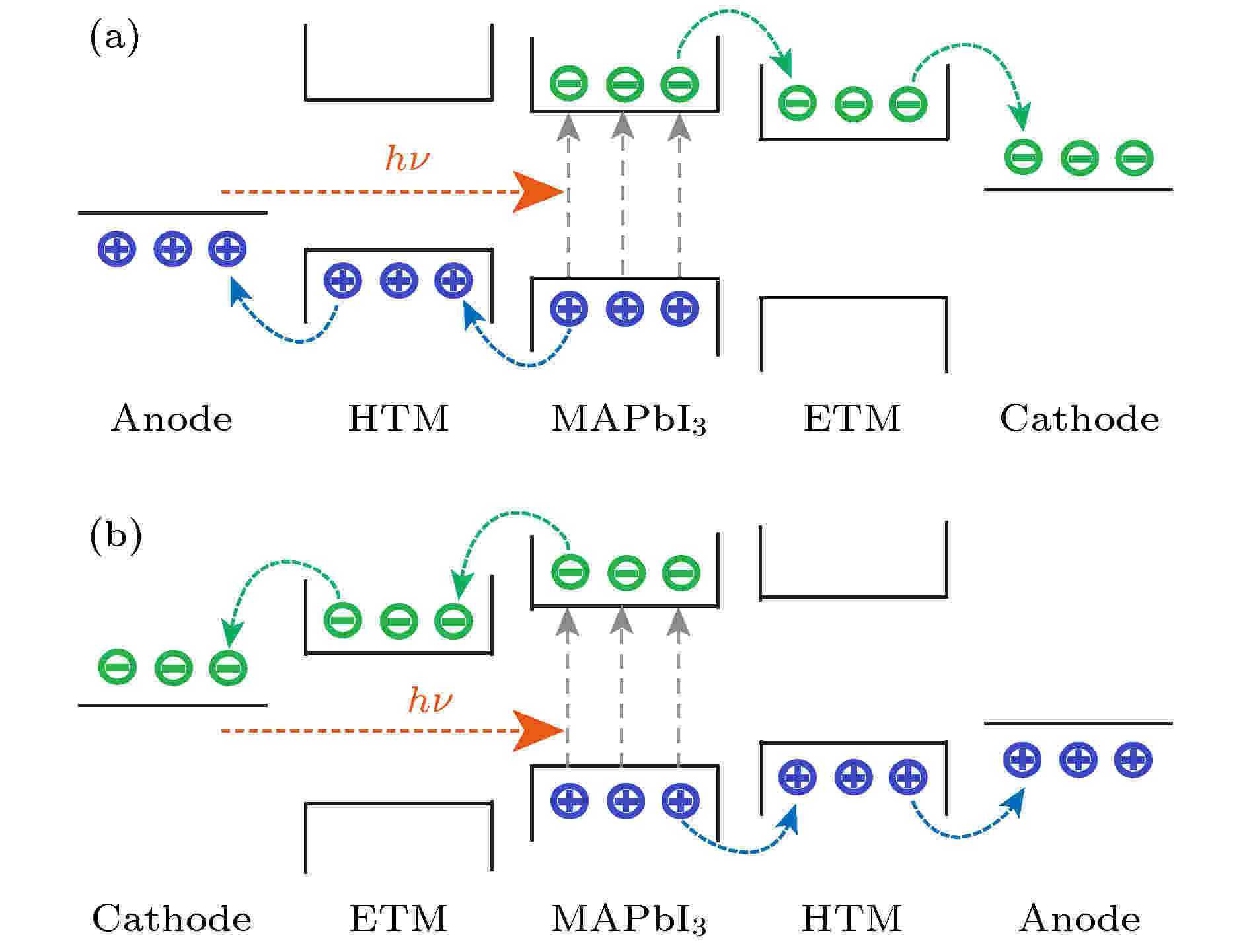
2020, 69 (11): 118801.
doi:10.7498/aps.69.20200089
Abstract +
The existence of serious hysteresis effect for regular perovskite solar cells (PSCs) will affect their performances, however, the inverted PSCs can significantly suppress the hysteresis effect. To data, it has been very rarely reported to simulate the inverted planar heterojunction PSCs. In this paper, the effects of hole transport material (HTM), electron transport material (ETM), and ITO work function on performance of inverted MAPbI3solar cells are carefully investigated in order to design the high-performance inverted PSCs. The inverted MAPbI3solar cells using Cu2O, CuSCN, or NiOxas HTM, and PC61BM, TiO2, or ZnO as ETM are simulated with the program AMPS-1D. Simulation results reveal that i) the inverted MAPbI3solar cells choosing NiOxas HTM can effectively improve the photovoltaic performance, and the excellent photovoltaic performance obtained by using TiO2as ETM is almost the same as by using ZnO as ETM; ii) the ITO work function increasing from 4.6 eV to 5.0 eV can significantly enhance the photovoltaic performances of Cu2O— based and CuSCN— based inverted MAPbI3solar cells, and the NiOx— based inverted MAPbI3solar cells have only a minor photovoltaic performance enhancement; iii) based on the reported ITO work function between 4.6 eV and 4.8 eV, the maximum power conversion efficiency (PCE) of 27.075% and 29.588% for CuSCN— based and NiOx— based invertedMAPbI3solar cells are achieved when the ITO work function reaches 4.8 eV. The numerical simulation gives that the increase of hole mobility in CuSCN and NiOxfor ITO/CuSCN/MAPbI3/TiO2/Al and ITO/NiOx/MAPbI3/TiO2/Al can greatly improve the device performance. Experimentally, the maximum hole mobility 0.1 cm2·V–1·s–1in CuSCN restricts the photovoltaic performance improvement of CuSCN— based inverted MAPbI3solar cells, which means that there is still room for the improvement of cell performance through increasing the hole mobility in CuSCN. It is found that NiOxwith a reasonable energy-band structure and high hole mobility 120 cm2·V–1·s–1is an ideal HTM in inverted MAPbI3solar cells. However, the increasing of electron mobility in TiO2cannot improve the device photovoltaic performance of inverted MAPbI3solar cells. These simulation results reveal the effects of ETM, HTM, and ITO work function on the photovoltaic performance of inverted MAPbI3solar cells. Our researches may help to design the high-performance inverted PSCs.
GEOPHYSICS, ASTRONOMY, AND ASTROPHYSICS
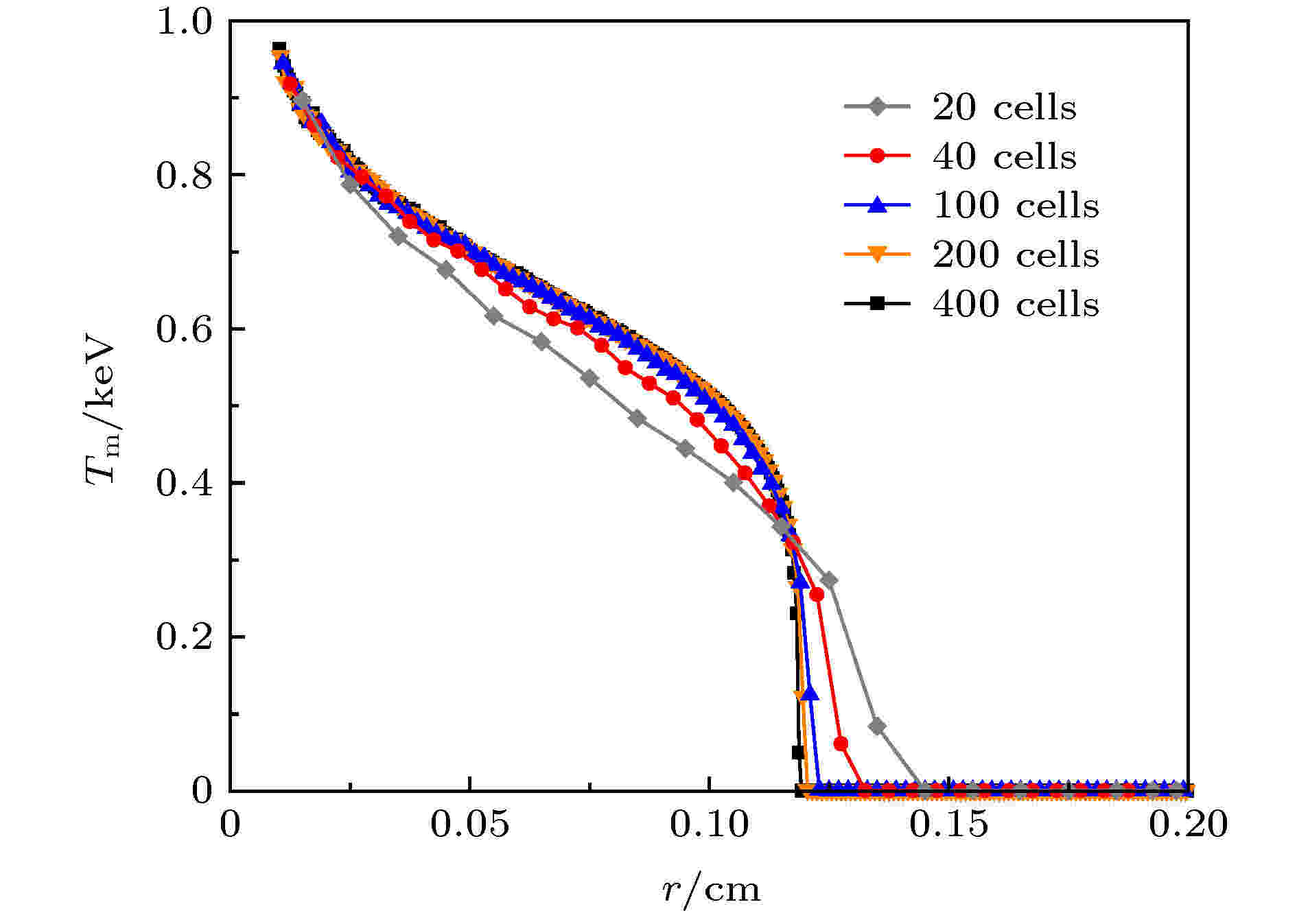
EDITOR'S SUGGESTION
2020, 69 (11): 119501.
doi:10.7498/aps.69.20200024
Abstract +
Sampling of radiation source particles is important for obtaining a correct result in the thermal radiative transfer simulation with implicit Monte Carlo. When conducting the implicit Monte Carlo simulation of spherical geometry, temperature in a cell (a spherical shell) is generally treated as a spatially independent value. That means that the particles of radiative source are uniformly distributed in a spherical shell. In some cases where the gradient of temperature inside a cell is relatively small, the treatment does not cause too many errors. However, when the opacity of material becomes large enough or the spherical shell becomes thick enough, the temperature of thermal wave head will change sharply and there will be a great temperature gradient even in a single spherical shell. The treatment will make the thermal radiation propagate much faster than the practical one, which is unacceptable in physics. We investigate the physical and numerical reasons for this violation, finding that the simulation results strongly rely on the separation of cell and that the thermal wave propagates faster with the cell number decreasing. In order to yield an accurate result, the cell number has to increase up to a large enough value. Unfortunately, more cells need more particles to reduce the numerical variance, and more particles will cost more computation time and thus causing the simulation efficiency to lower. In our work, temperature is not treated as a constant in space any more. Instead, it is treated as a linear function in a cell. Based on a new temperature function and radiative energy density distribution, a probability density distribution function of emitting position of radiation source particle in spherical geometry is obtained. Then two new spatial sampling methods are proposed and the sampling procedures of radiation source particle are designed. To verify our new sampling methods, we test several typical thermal radiative problems and compare the result with a reference solution. Numerical experiments show that both two new sampling methods can correct the errors of thermal radiative propagation speed and overcome the difficulty that simulation result is strongly dependent on cell number. In addition, both new sampling methods can obtain an accurate result even with less cells and less particles, which can saves plenty of computation time and improves the simulation efficiency.
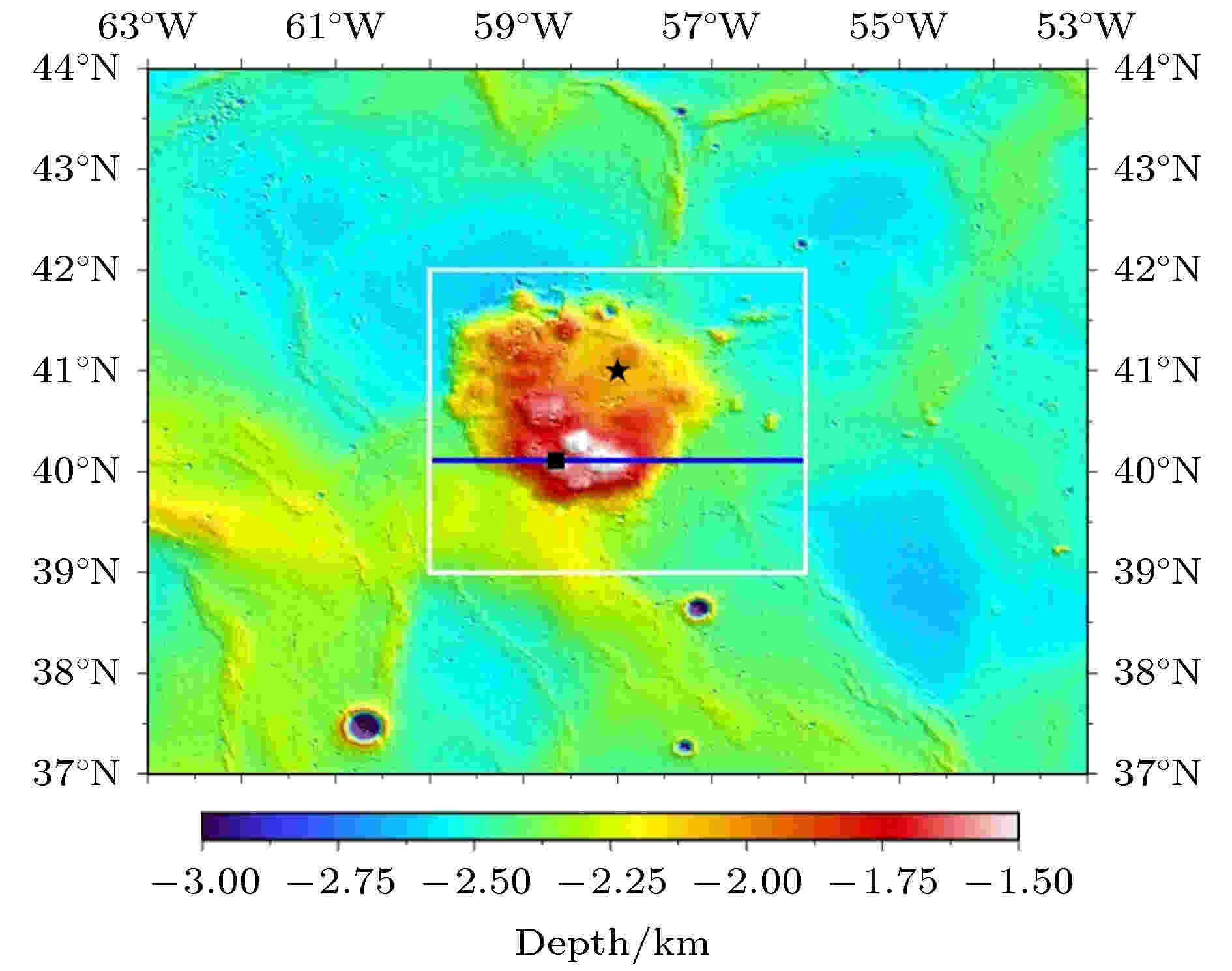
2020, 69 (11): 119601.
doi:10.7498/aps.69.20200114
Abstract +
The forthcoming lunar exploration of Chang’e-5 (CE-5) mission will be the first sampling return project of China. The actual drilling needs the information about real-time illumination and corresponding temperature. To give a support for the project, in this paper the SPICE software system is first used to calculate the real-time illumination at the CE-5 candidate landing site Mons Rümker. It is found that our synthetic map of illumination is consistent with the morning map of illumination provided by the Japan’s SELENE satellite. This result verifies the rationality of our algorithm and the corresponding code. According to the calculated illumination and considering a one-dimensional heat conduction model, we study the temperature distribution over Mons Rümker. It is found that the regolith temperature near the surface is greatly related to the illumination, but varies a little with the depth increasing. It is also discovered that the regolith temperature beneath a depth of 0.57 m will not change any more. To give a support for the actual drilling program, it is recommended to consider the temperature difference between the outside and inside of the regolith, especially their stresses caused by such a temperature difference. Moreover, considering the drilling depth of CE-5 larger than 0.57 m, it is likely to measure the heat flow for the constant-temperature layer. We propose that for the next lunar exploration following CE-5 the measurement of heat flow is considered. This will promote the research of lunar science.












